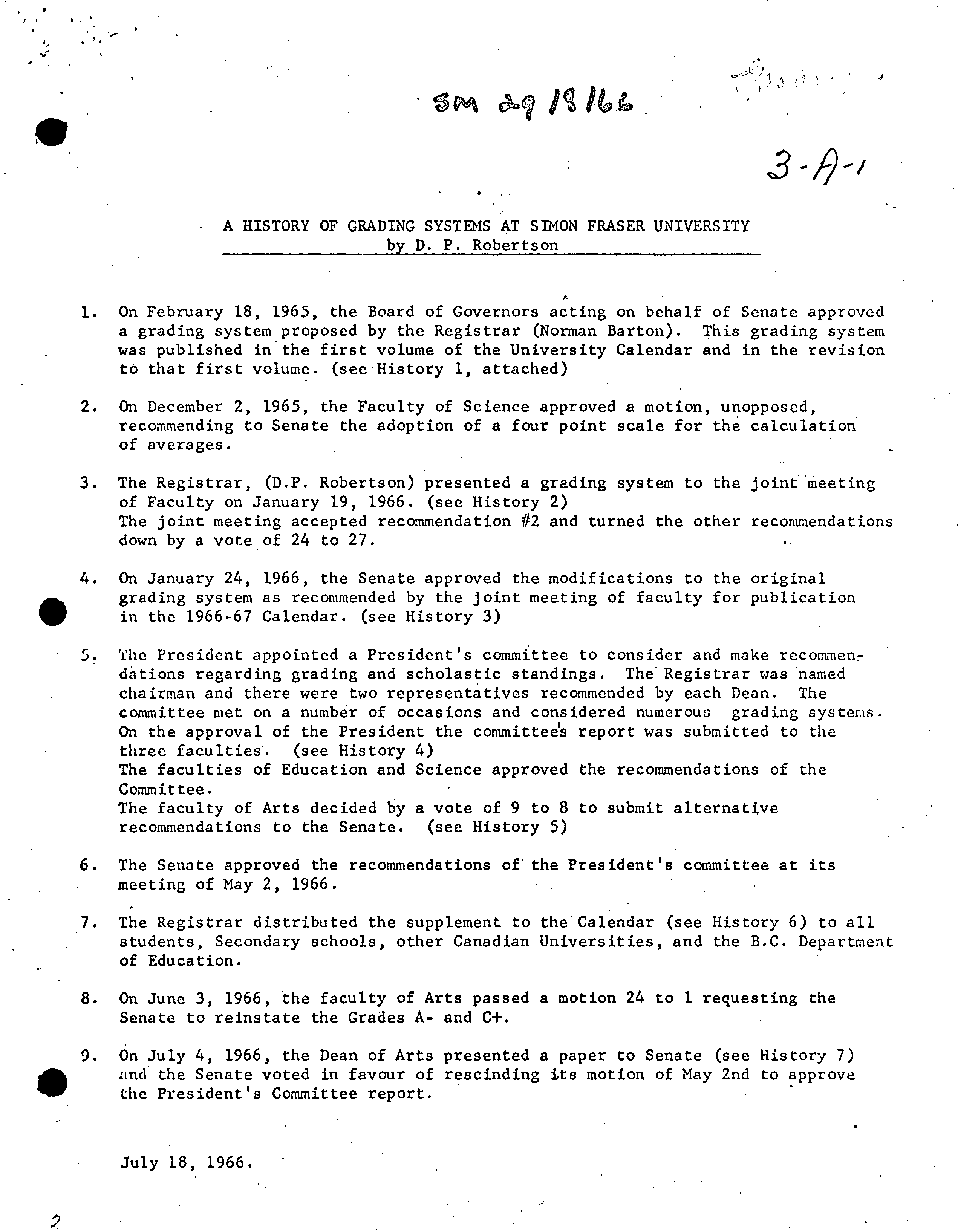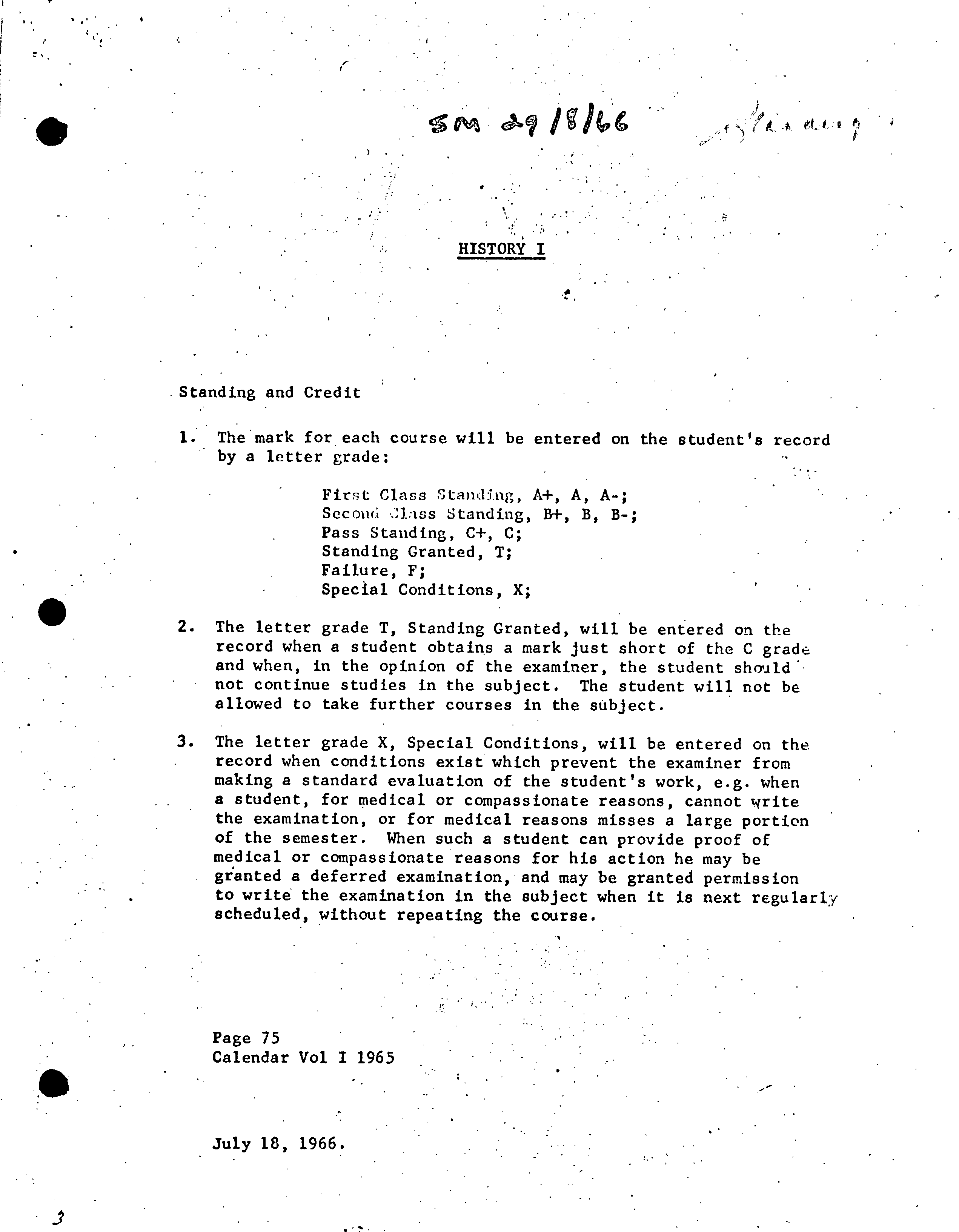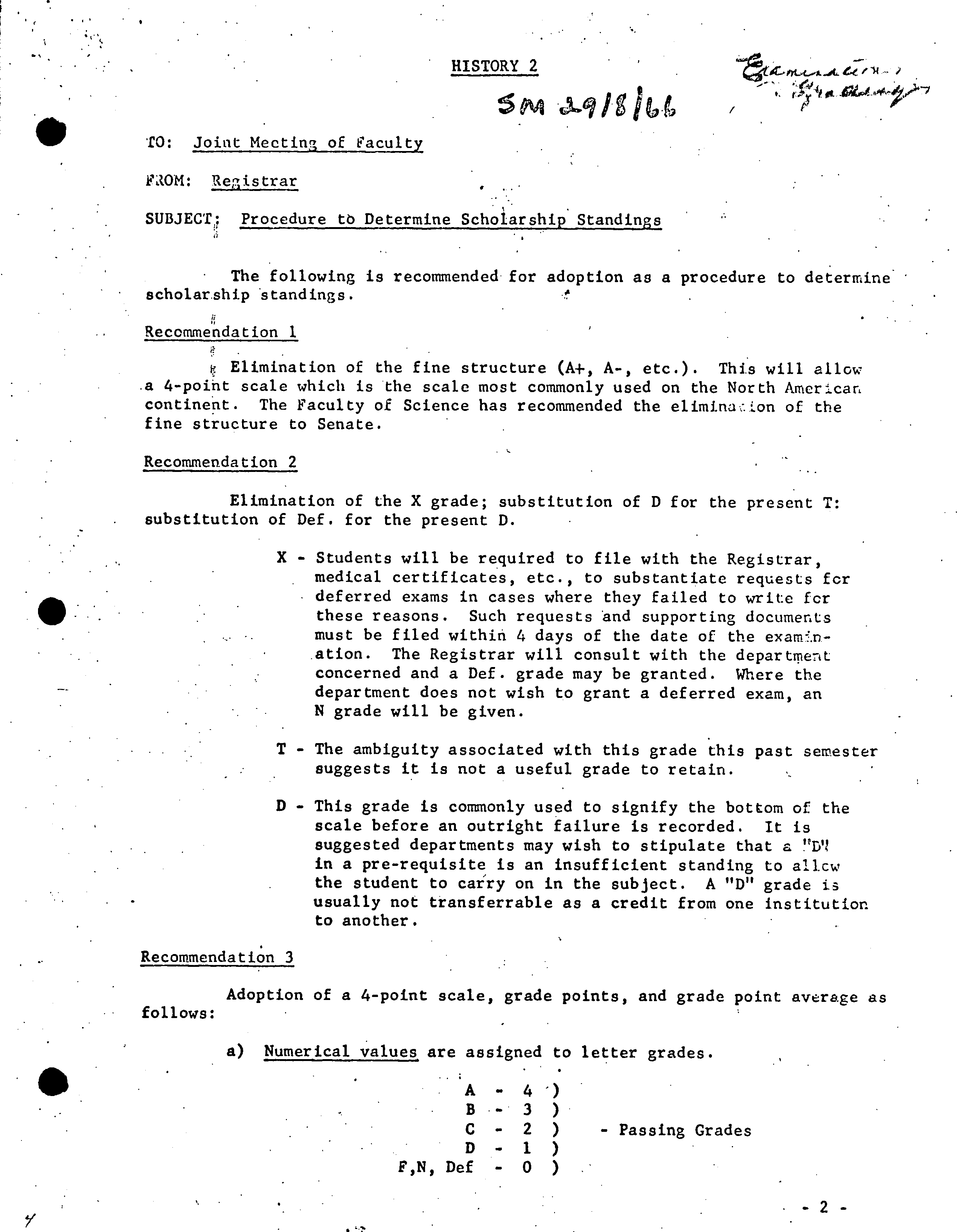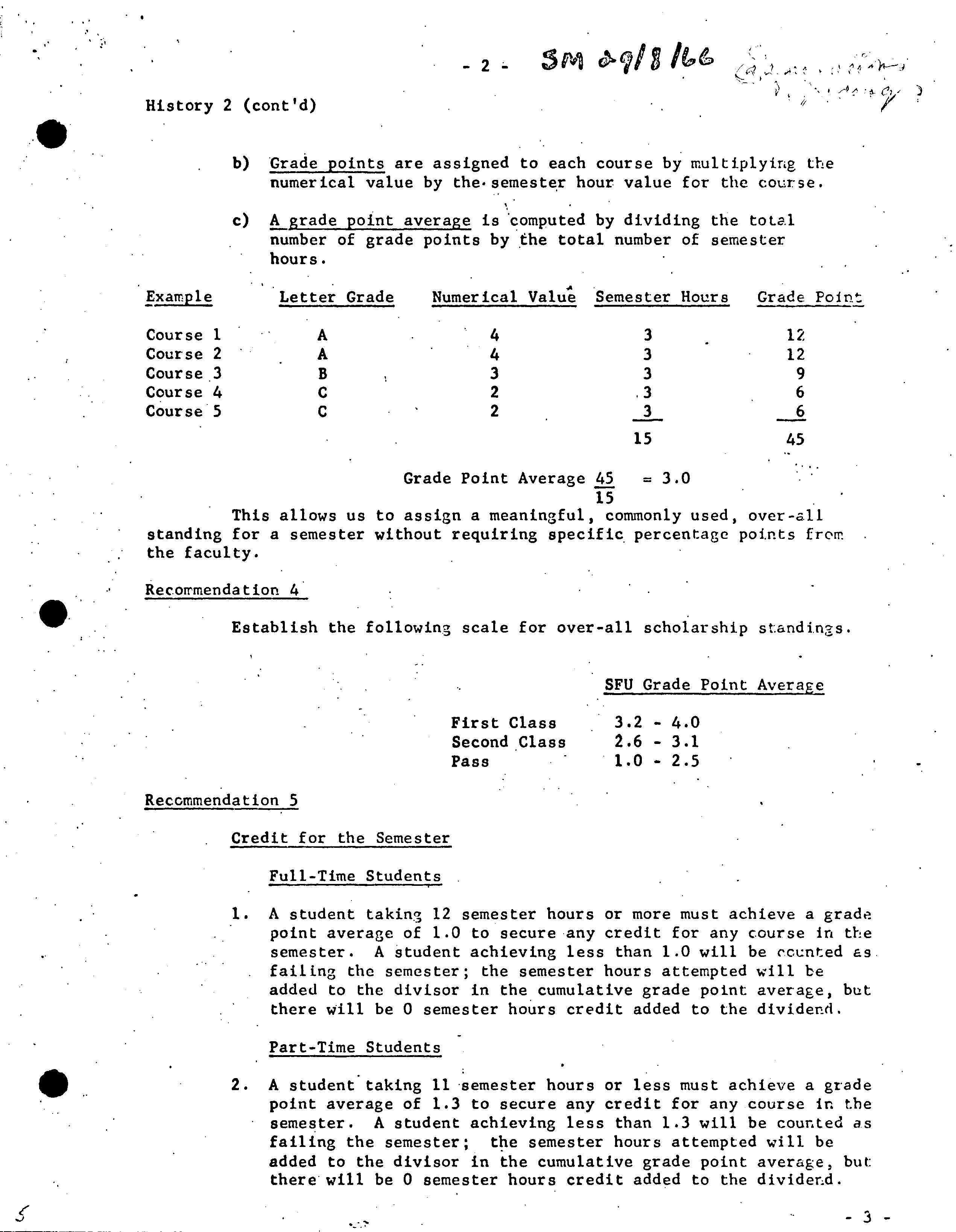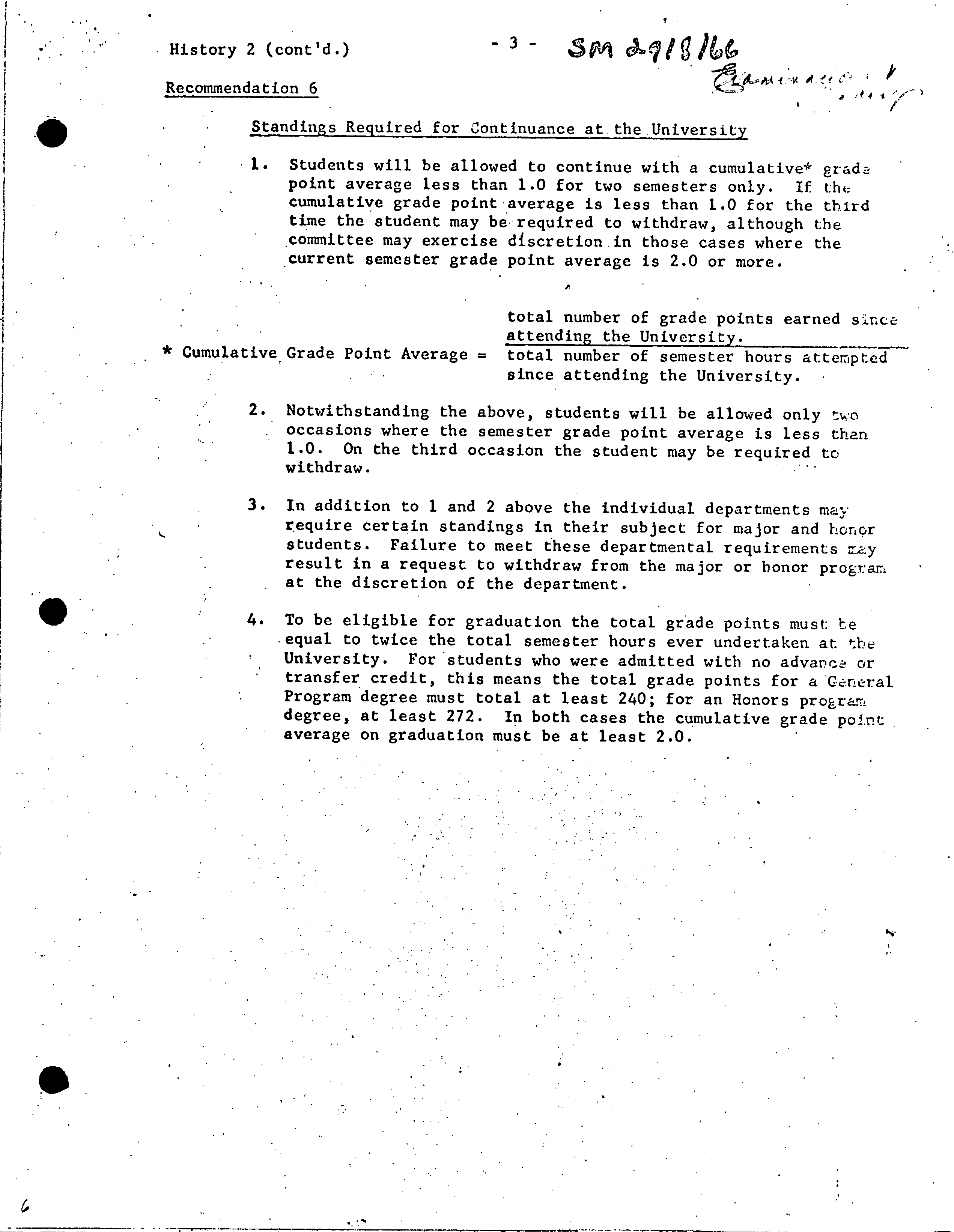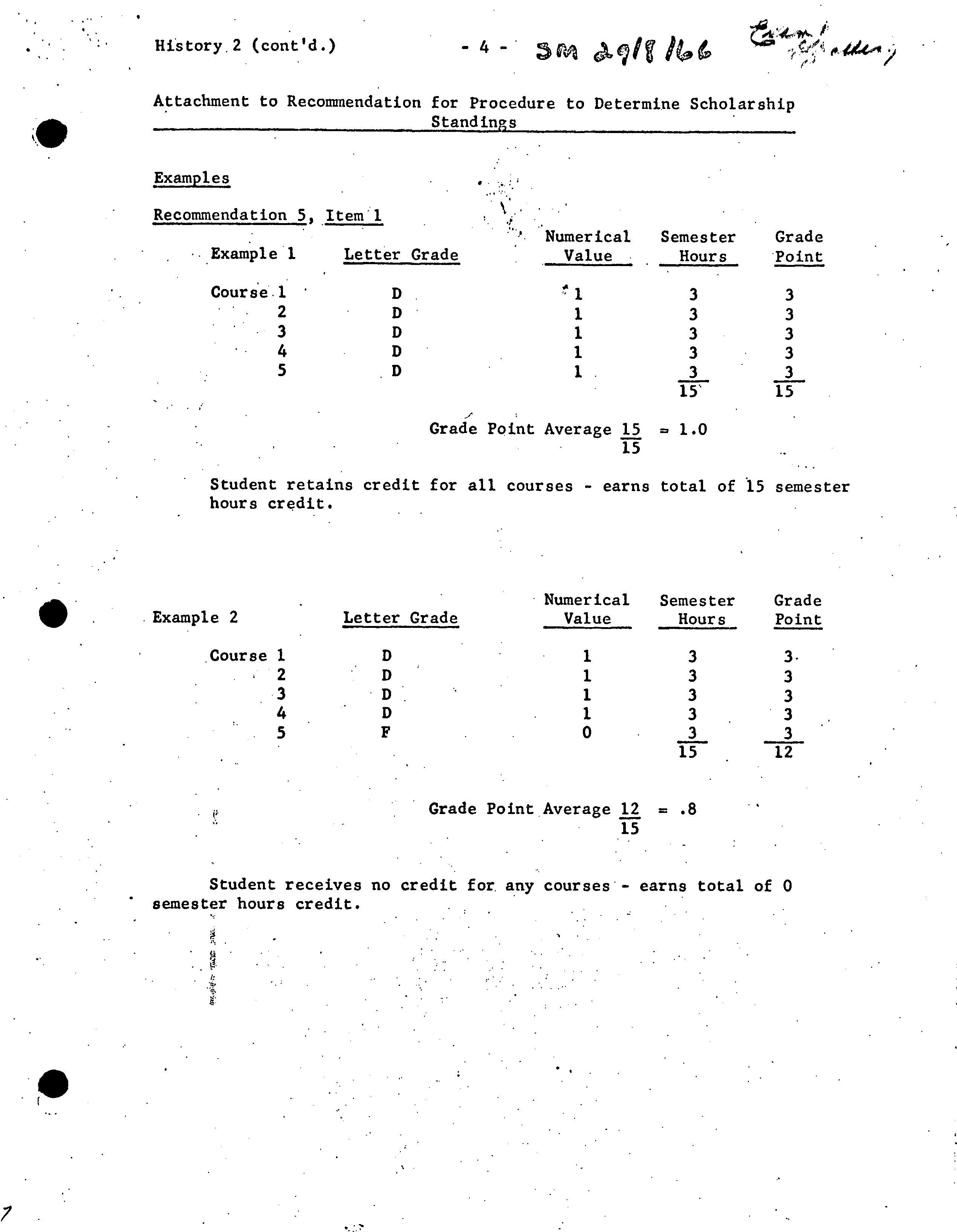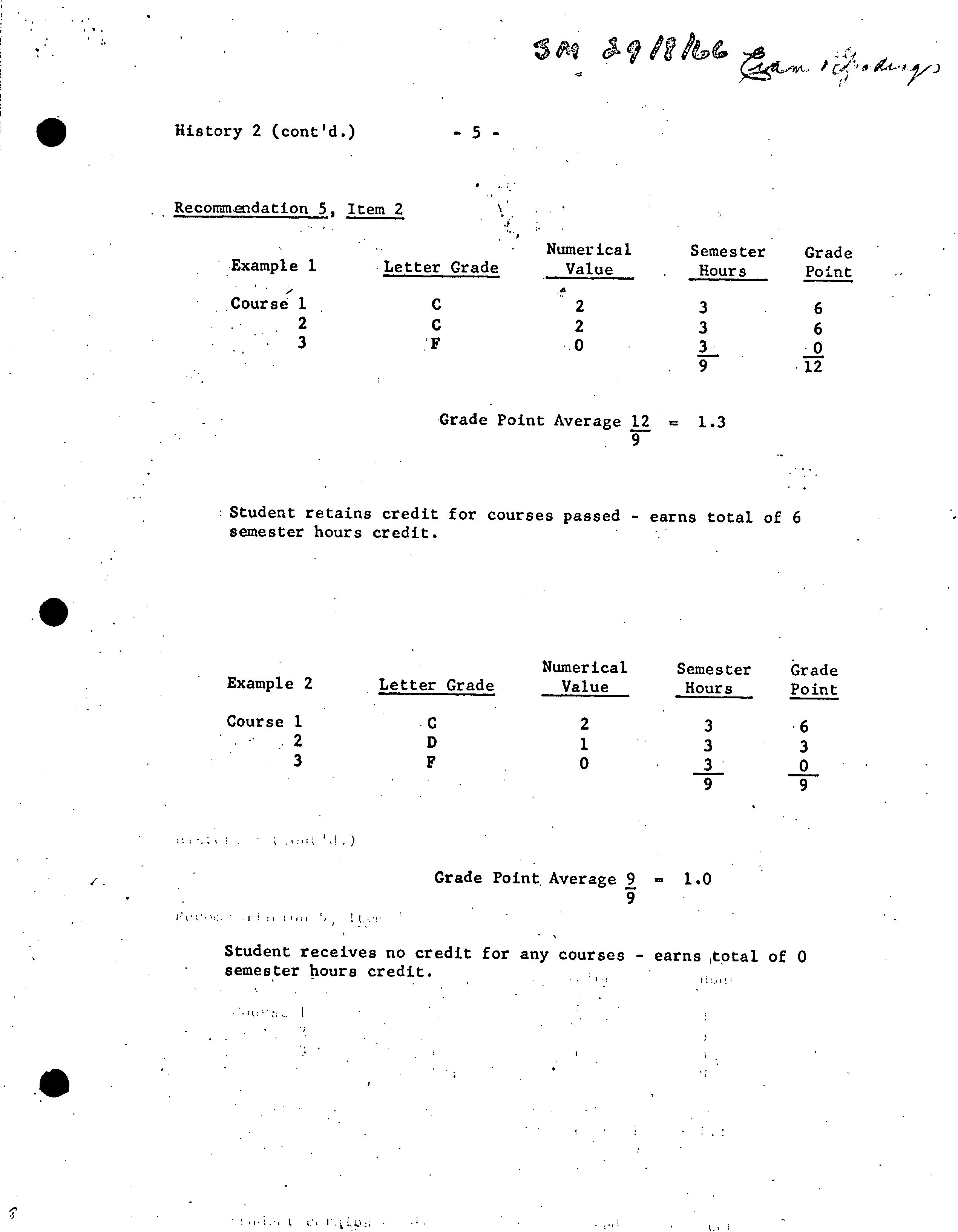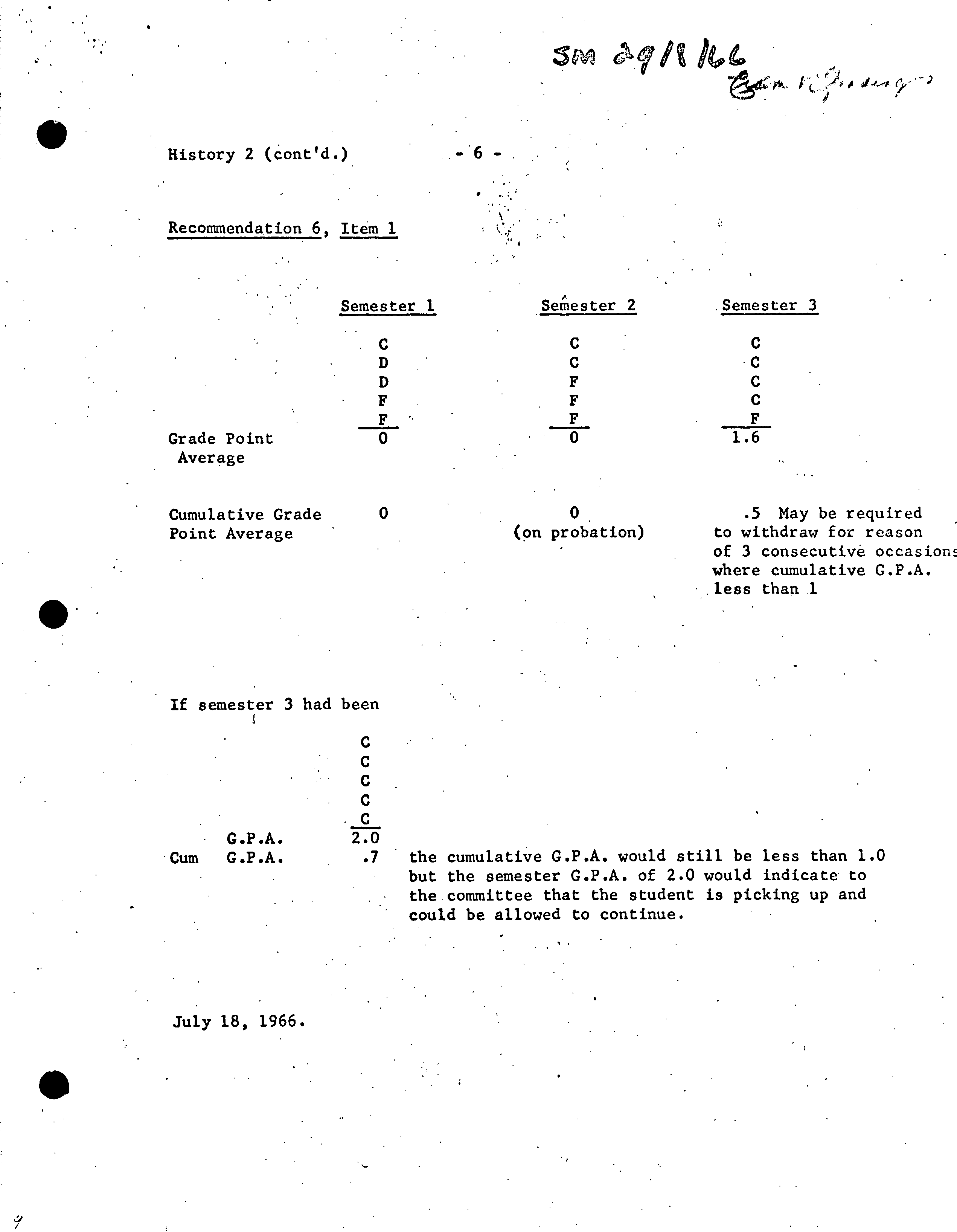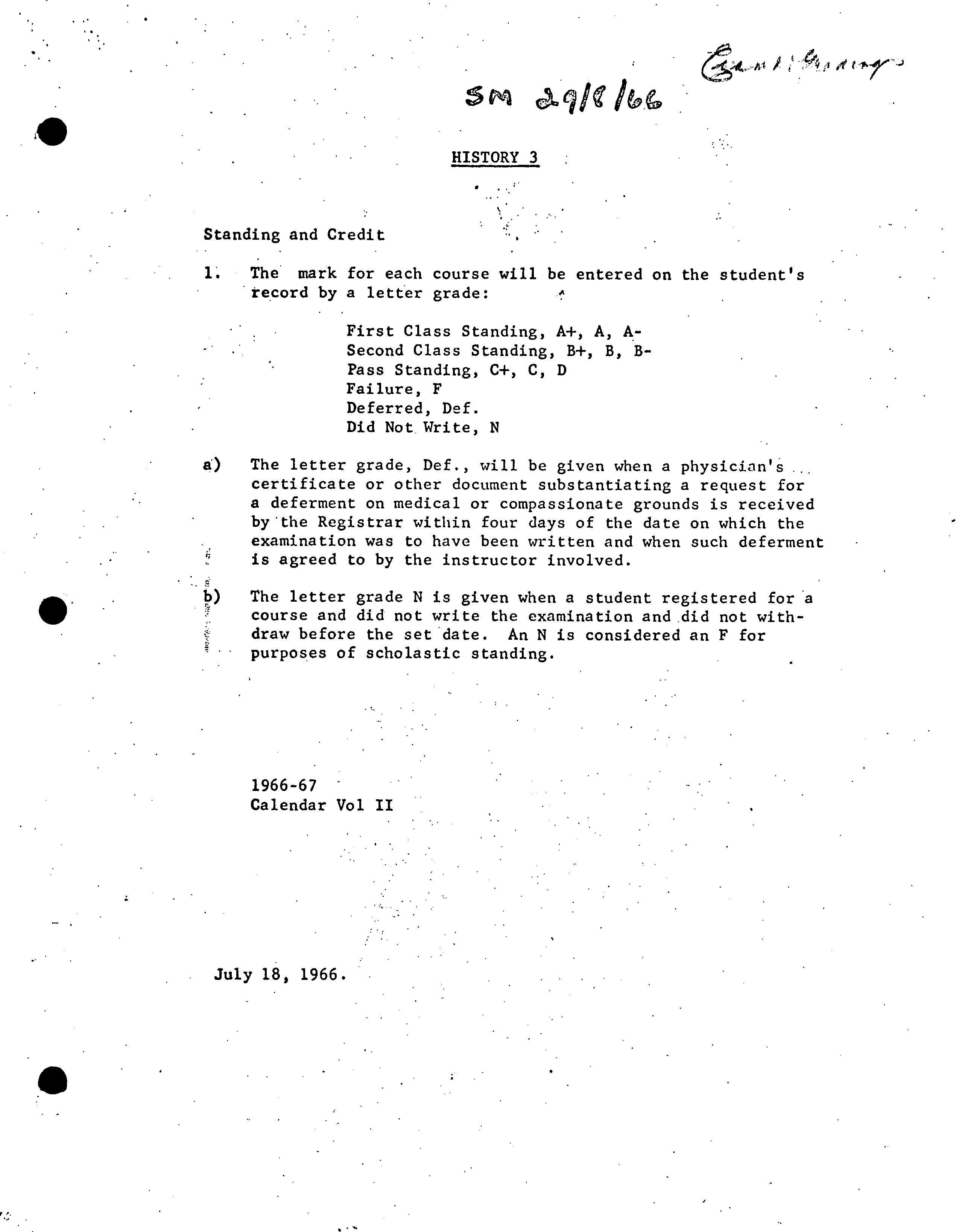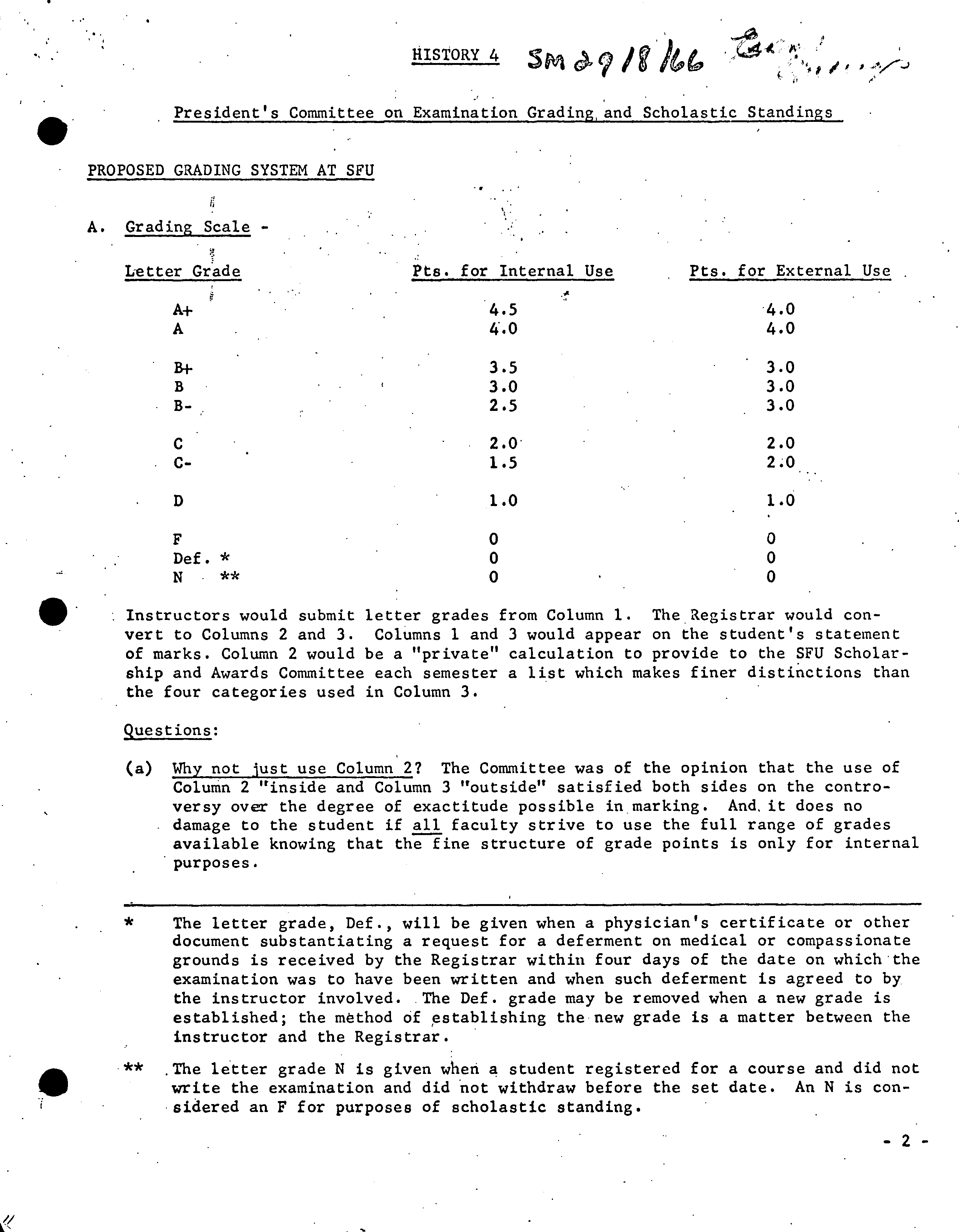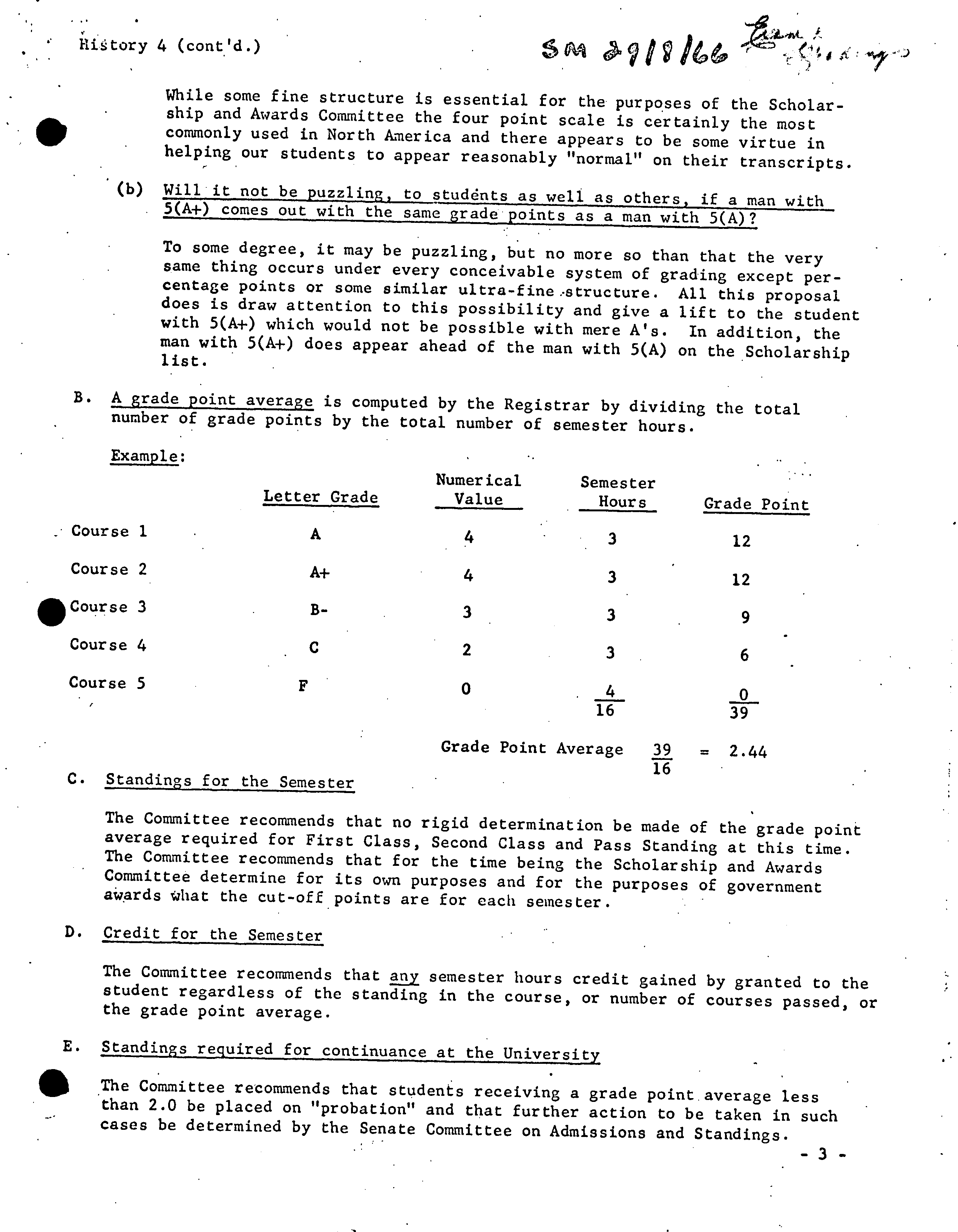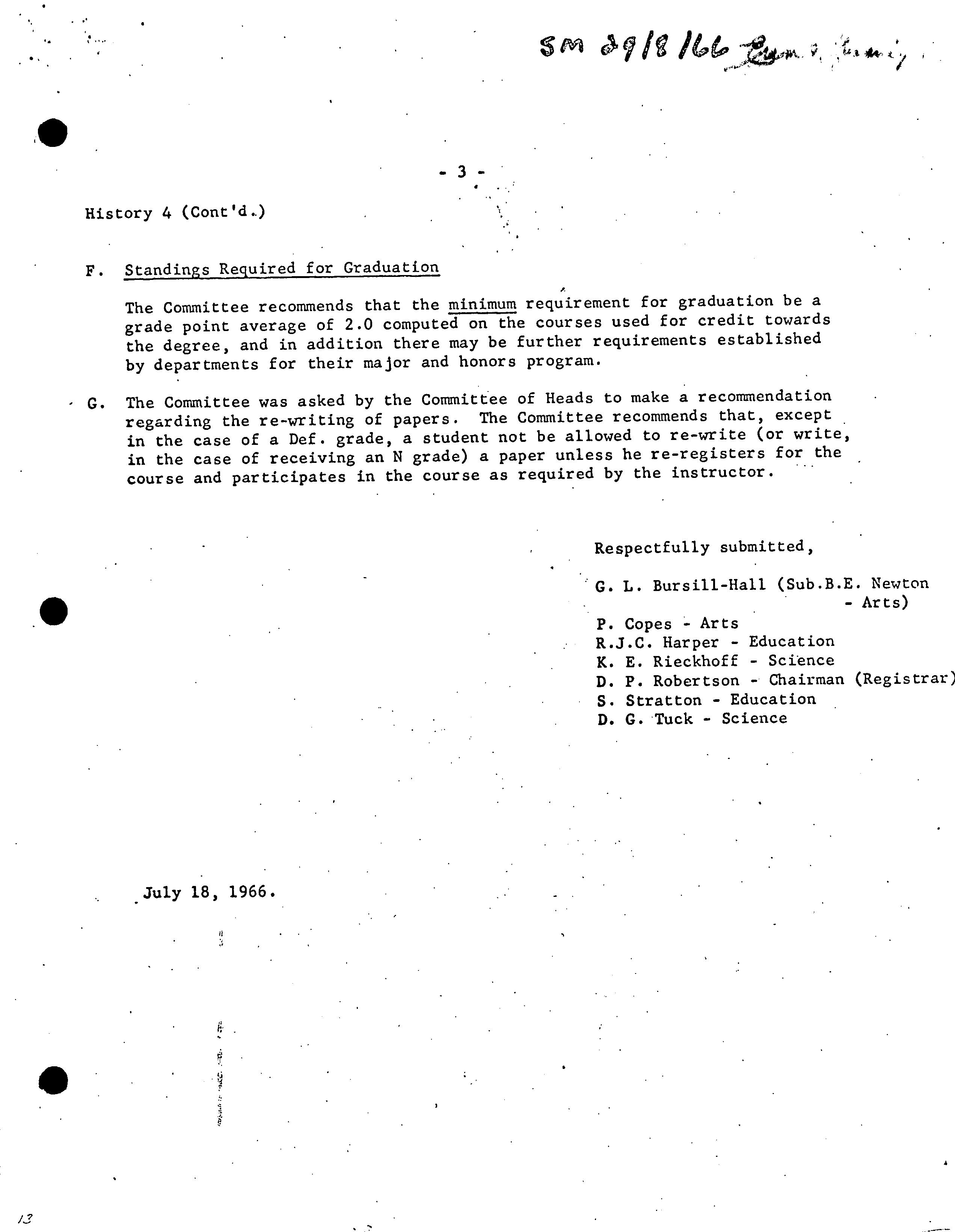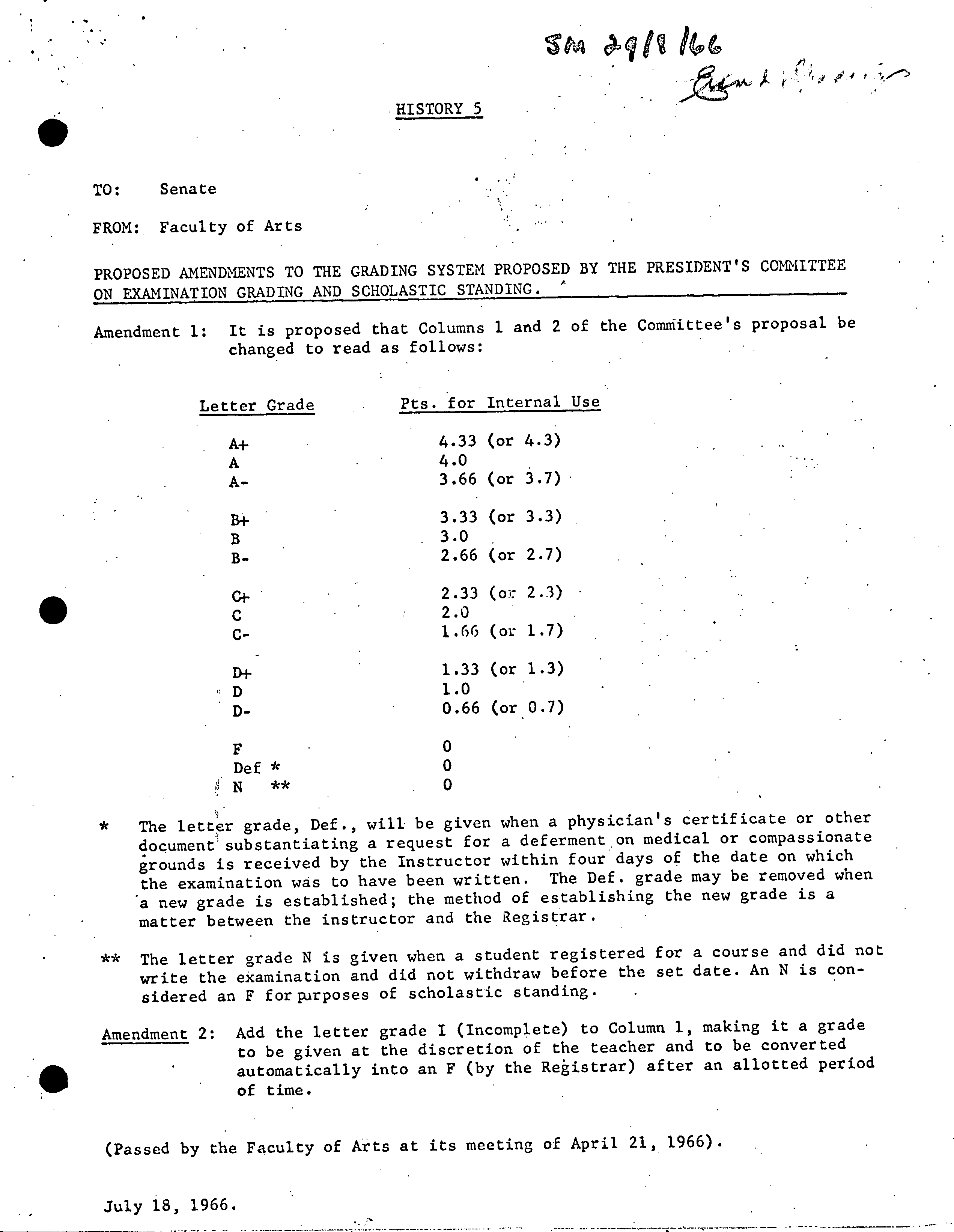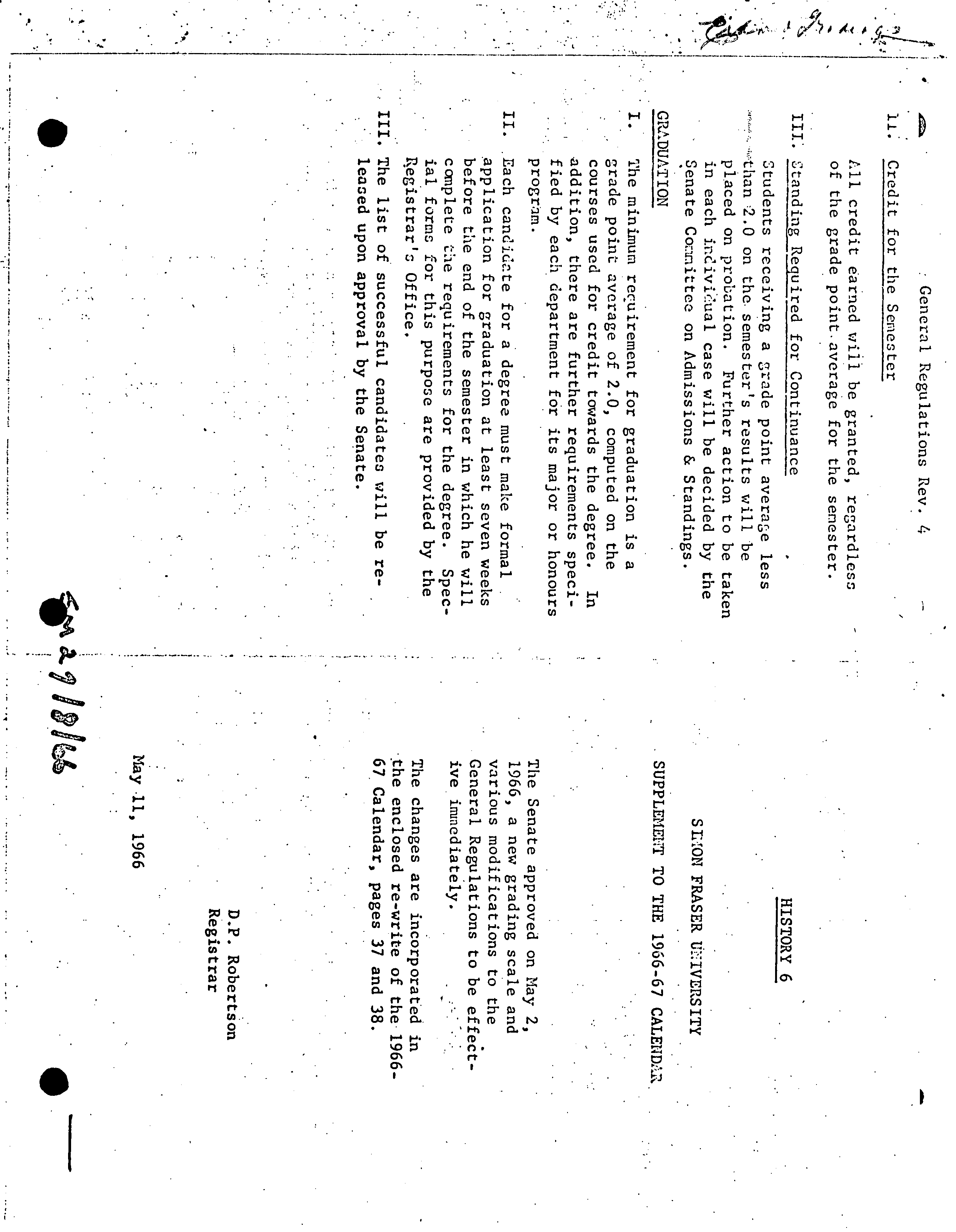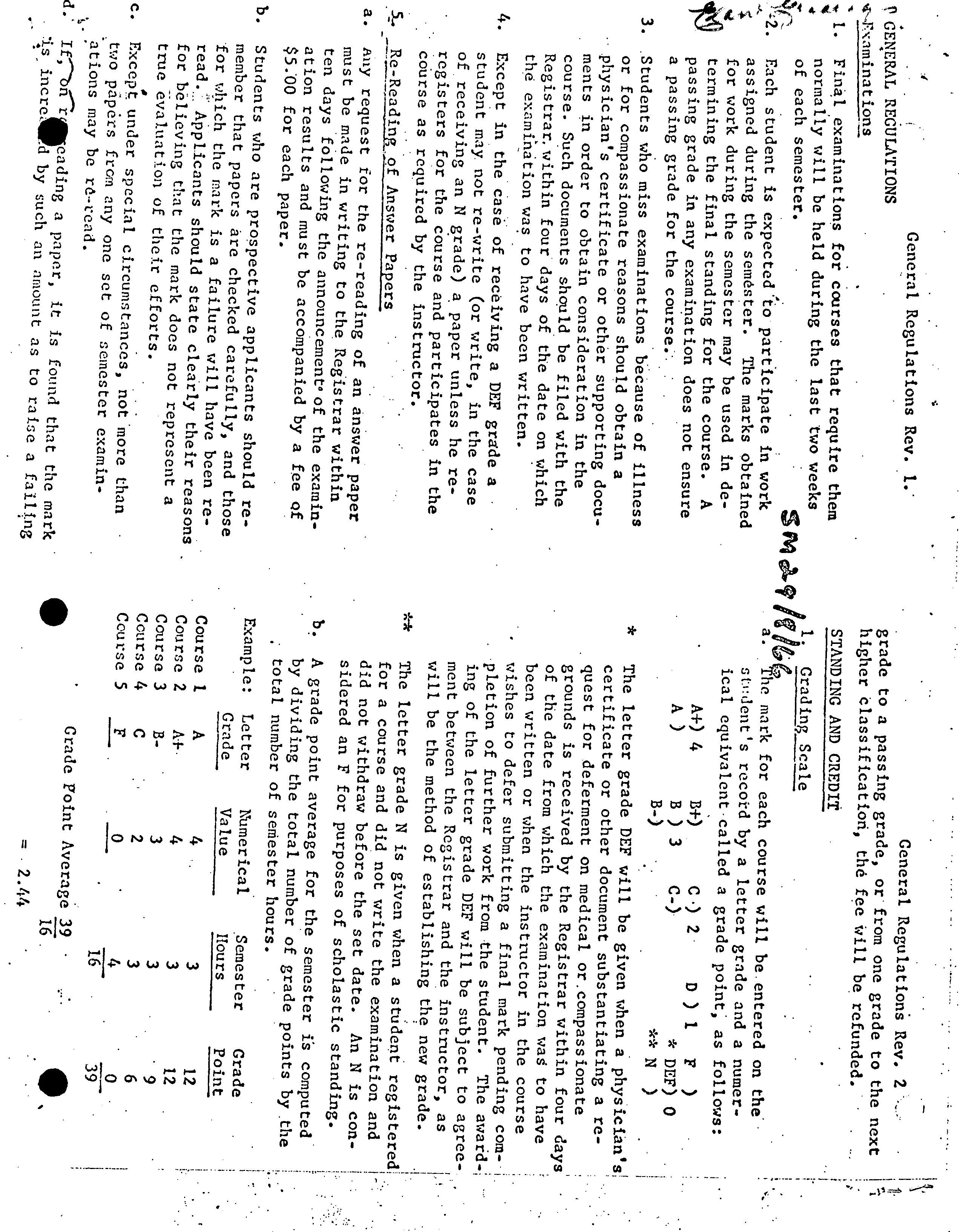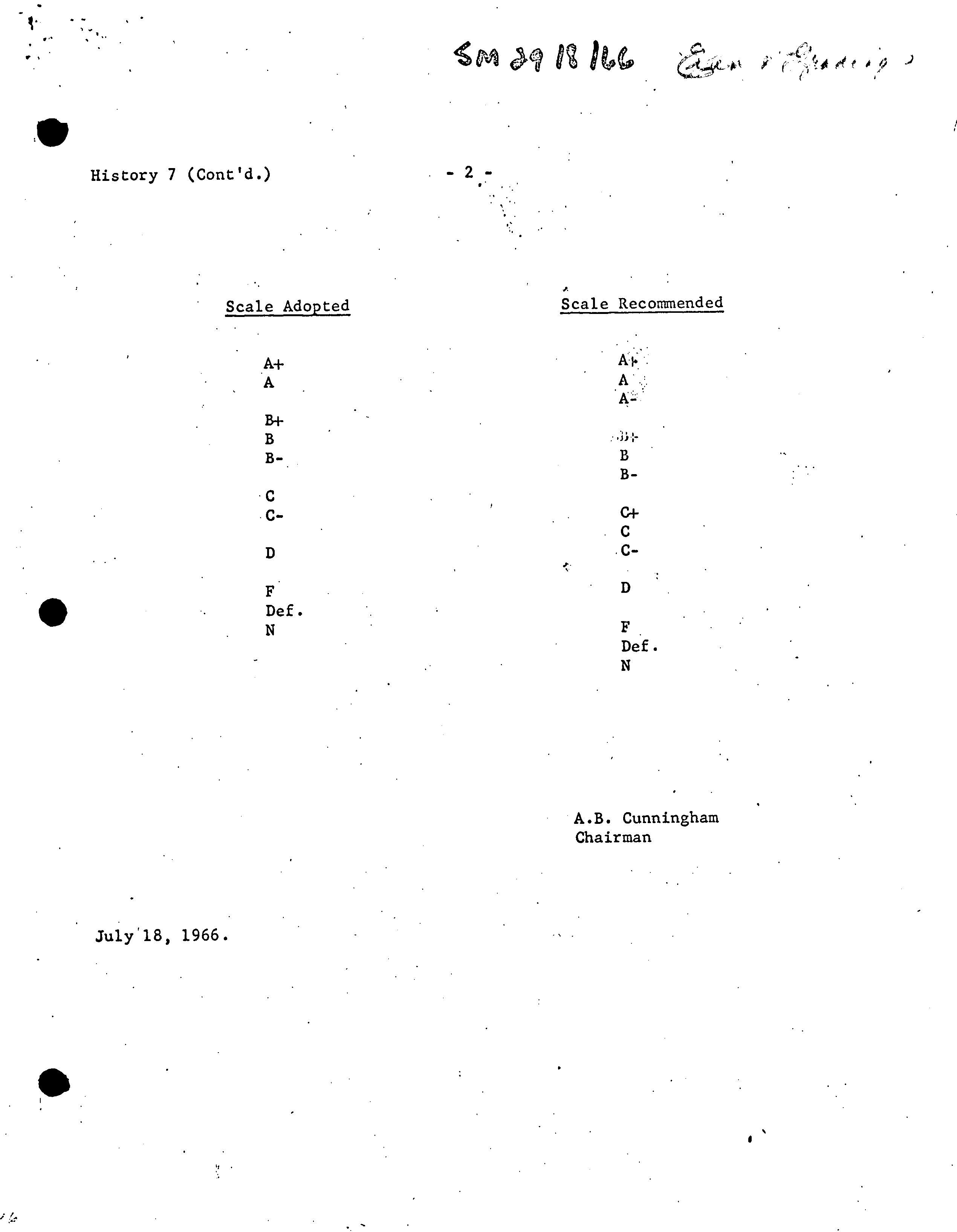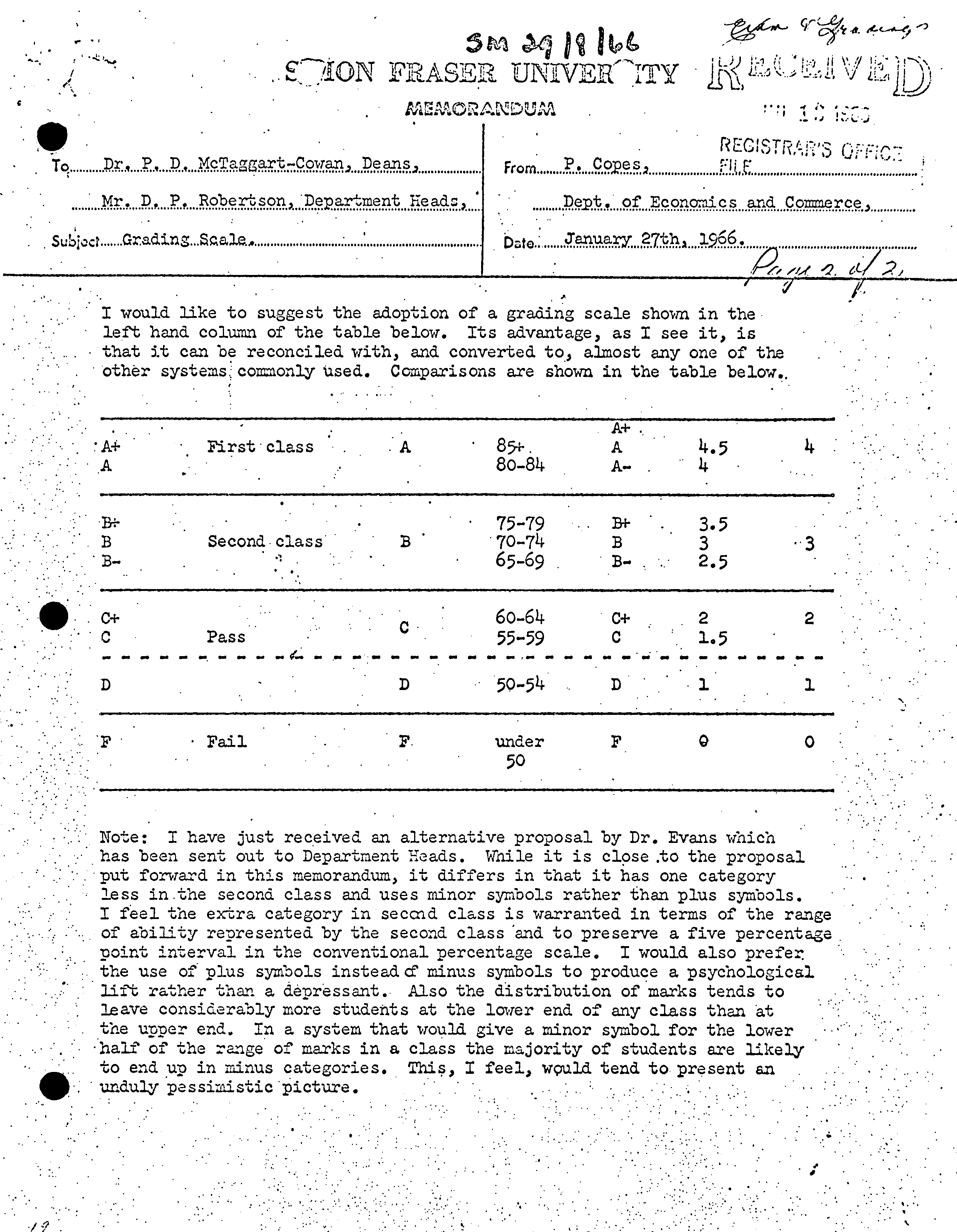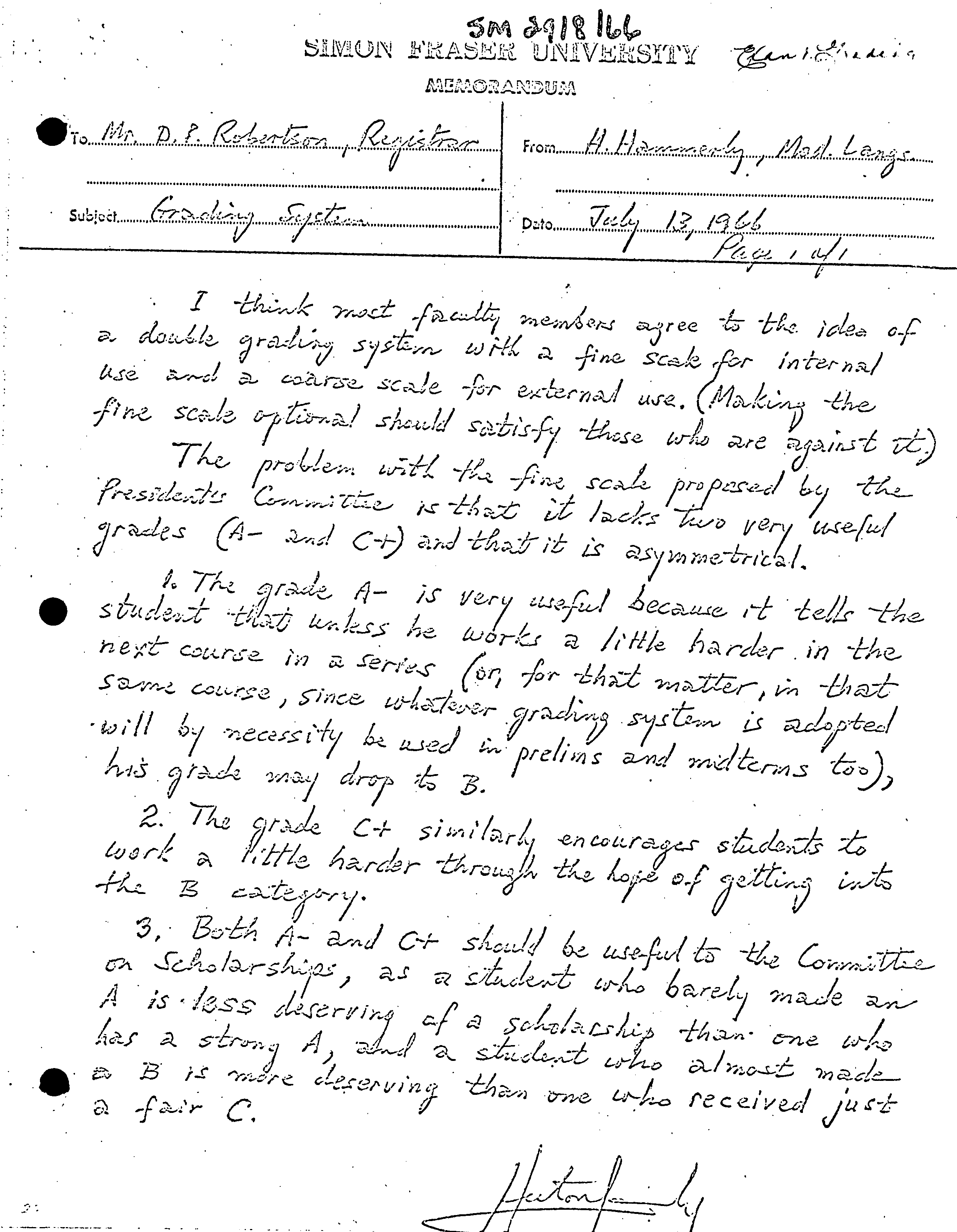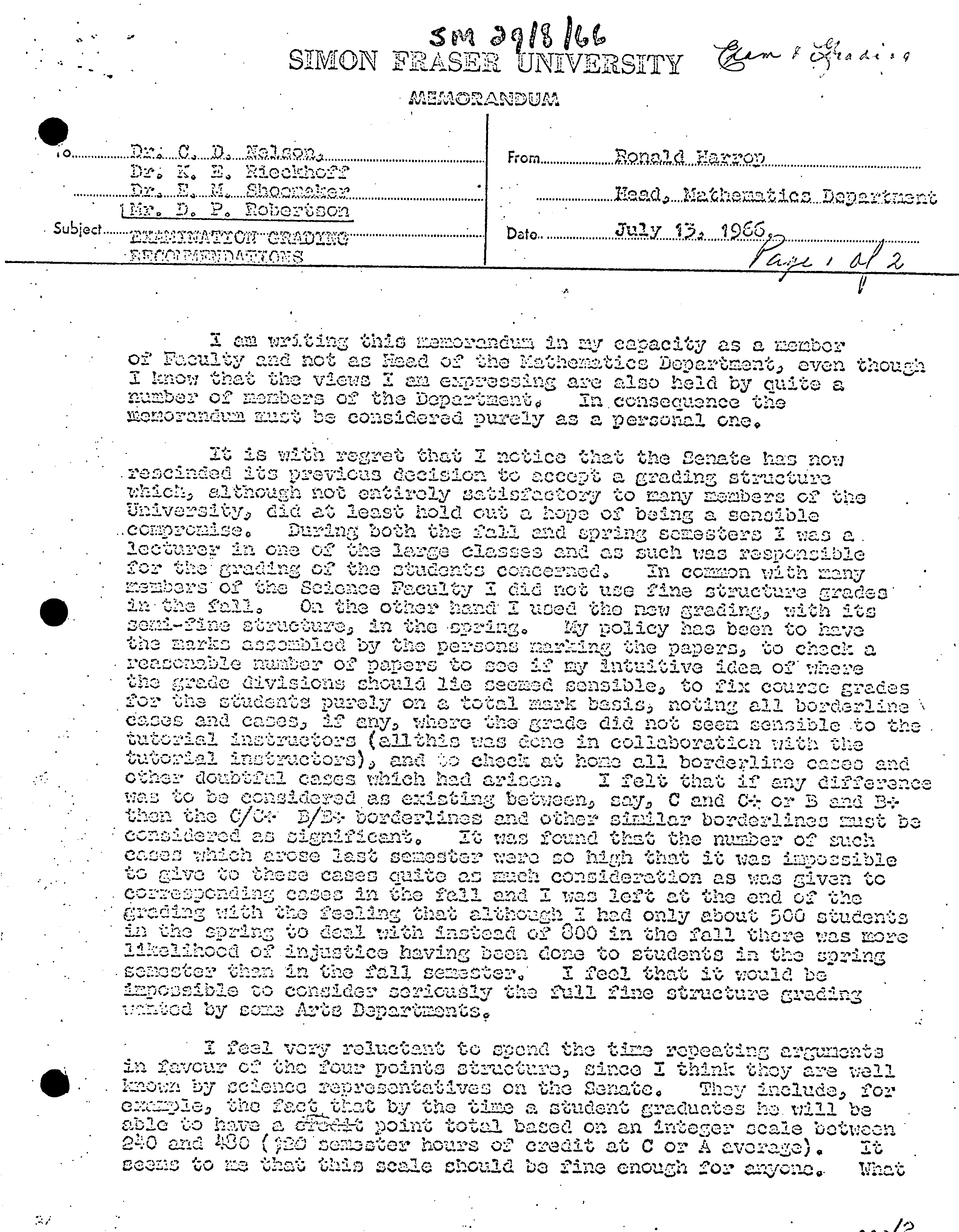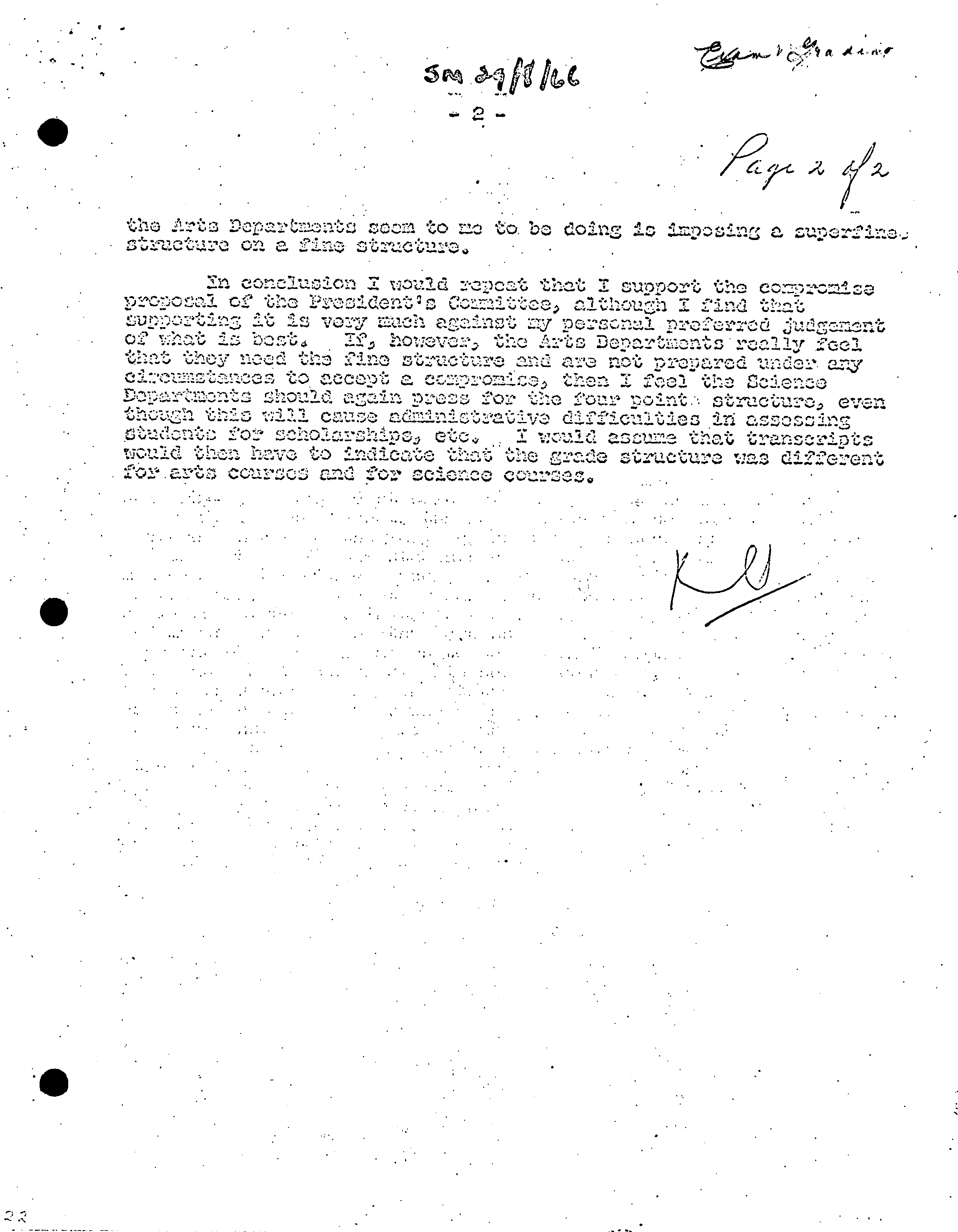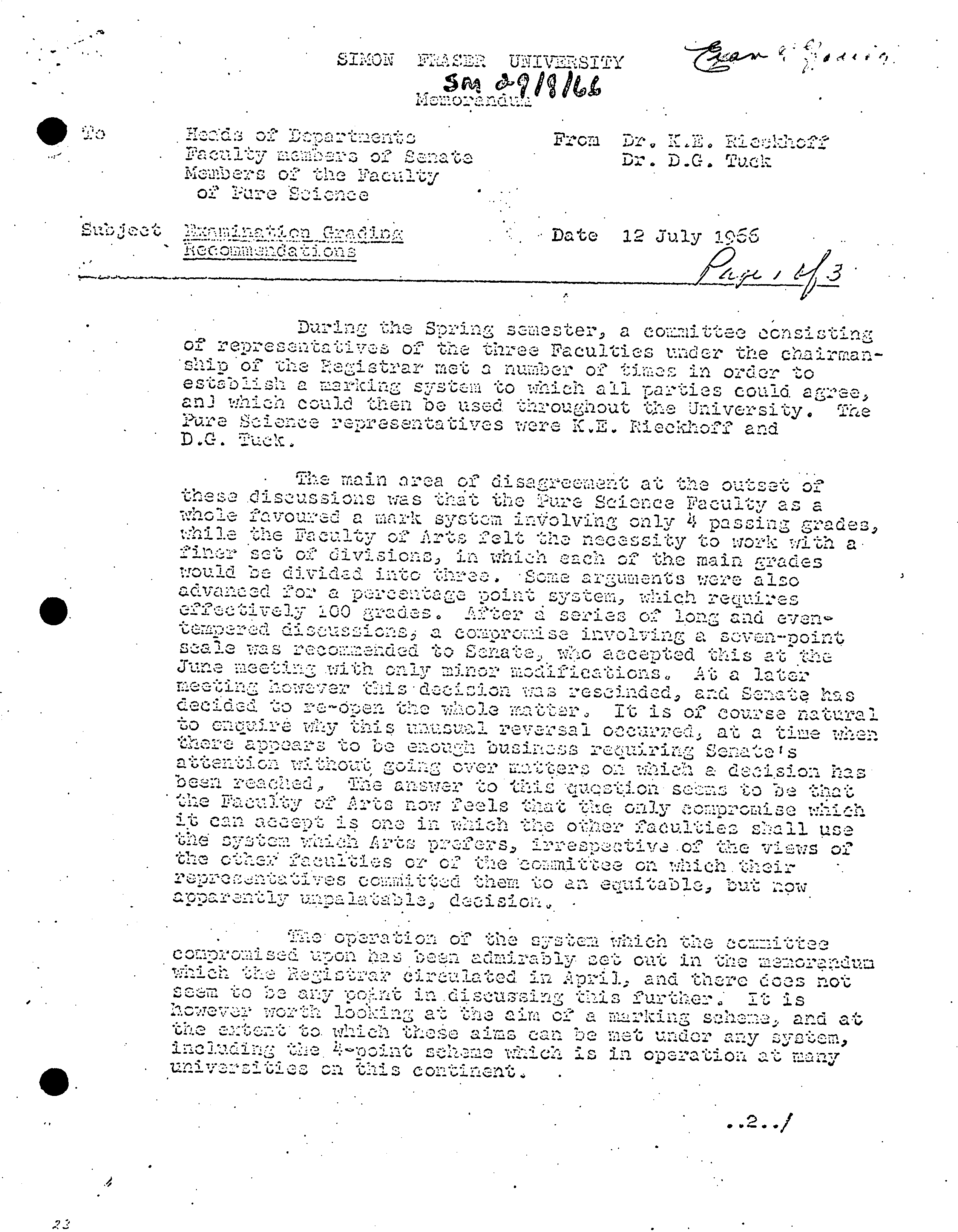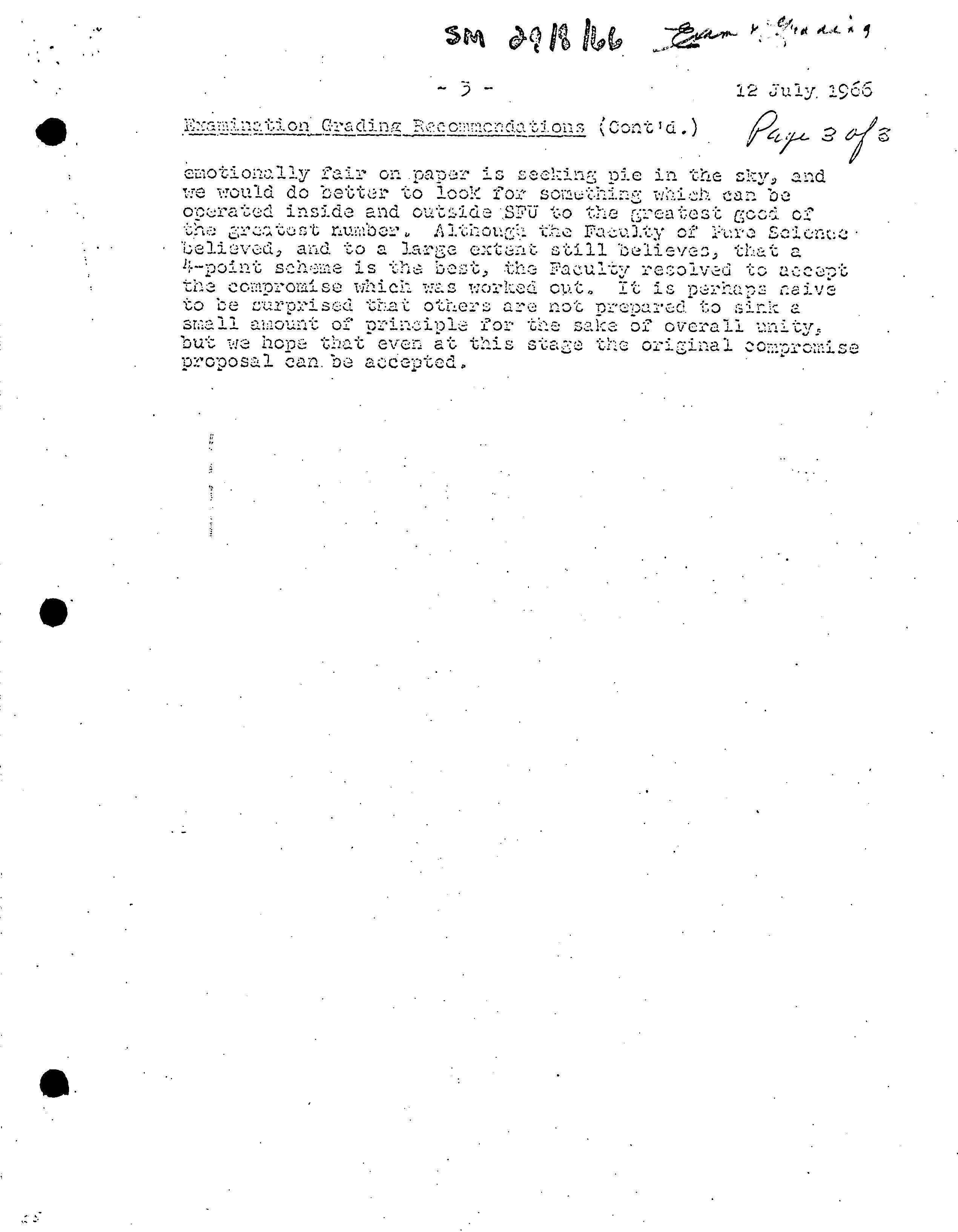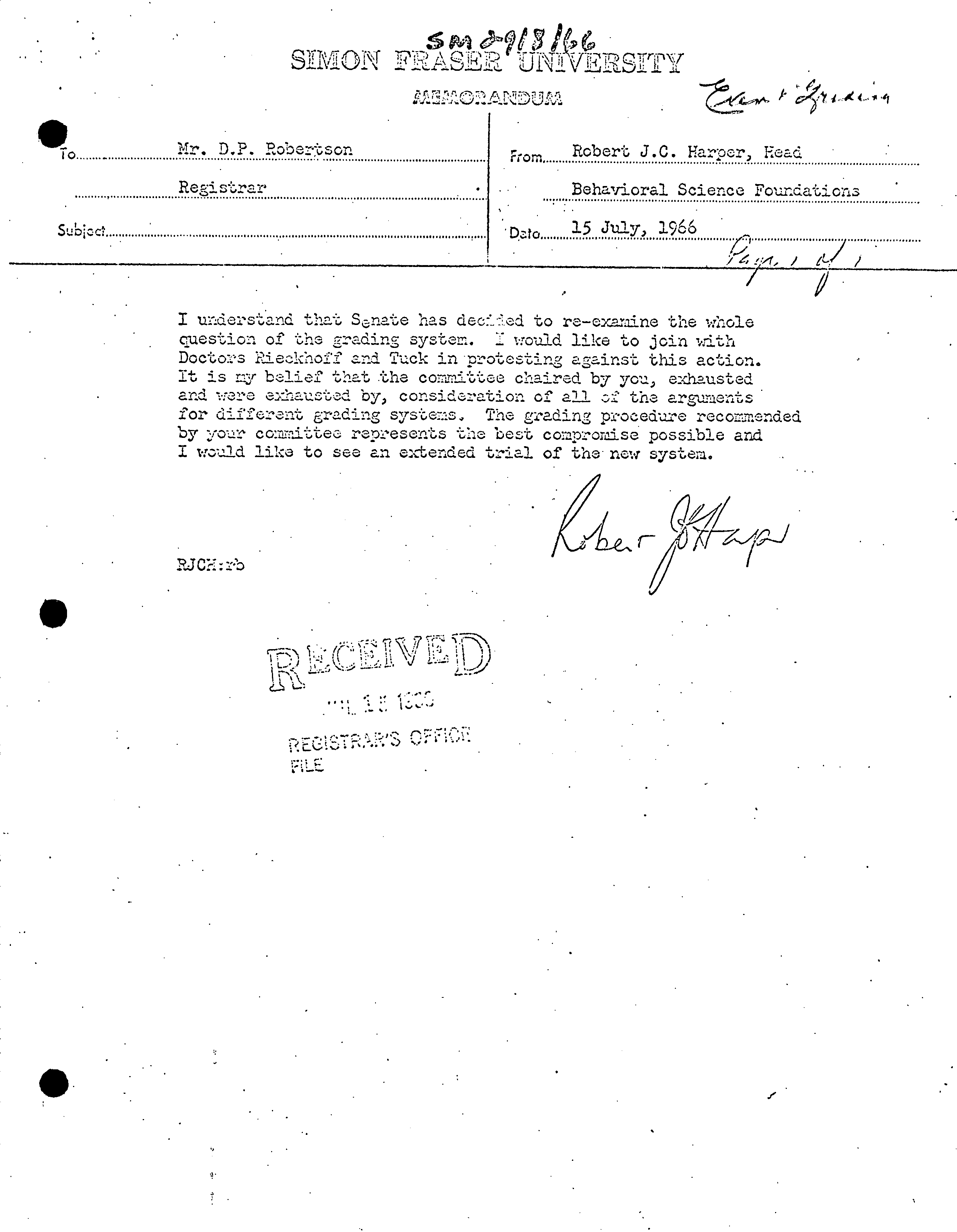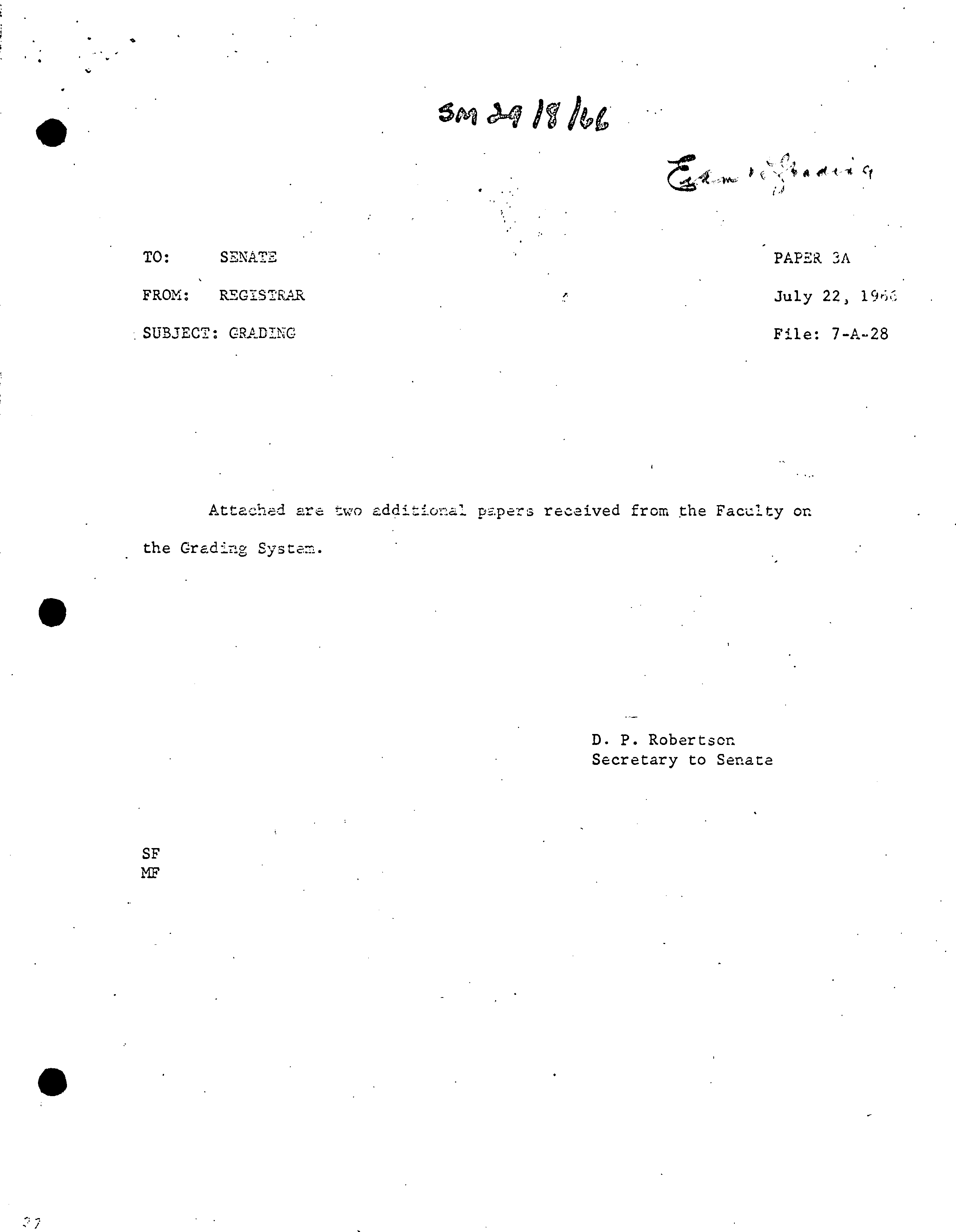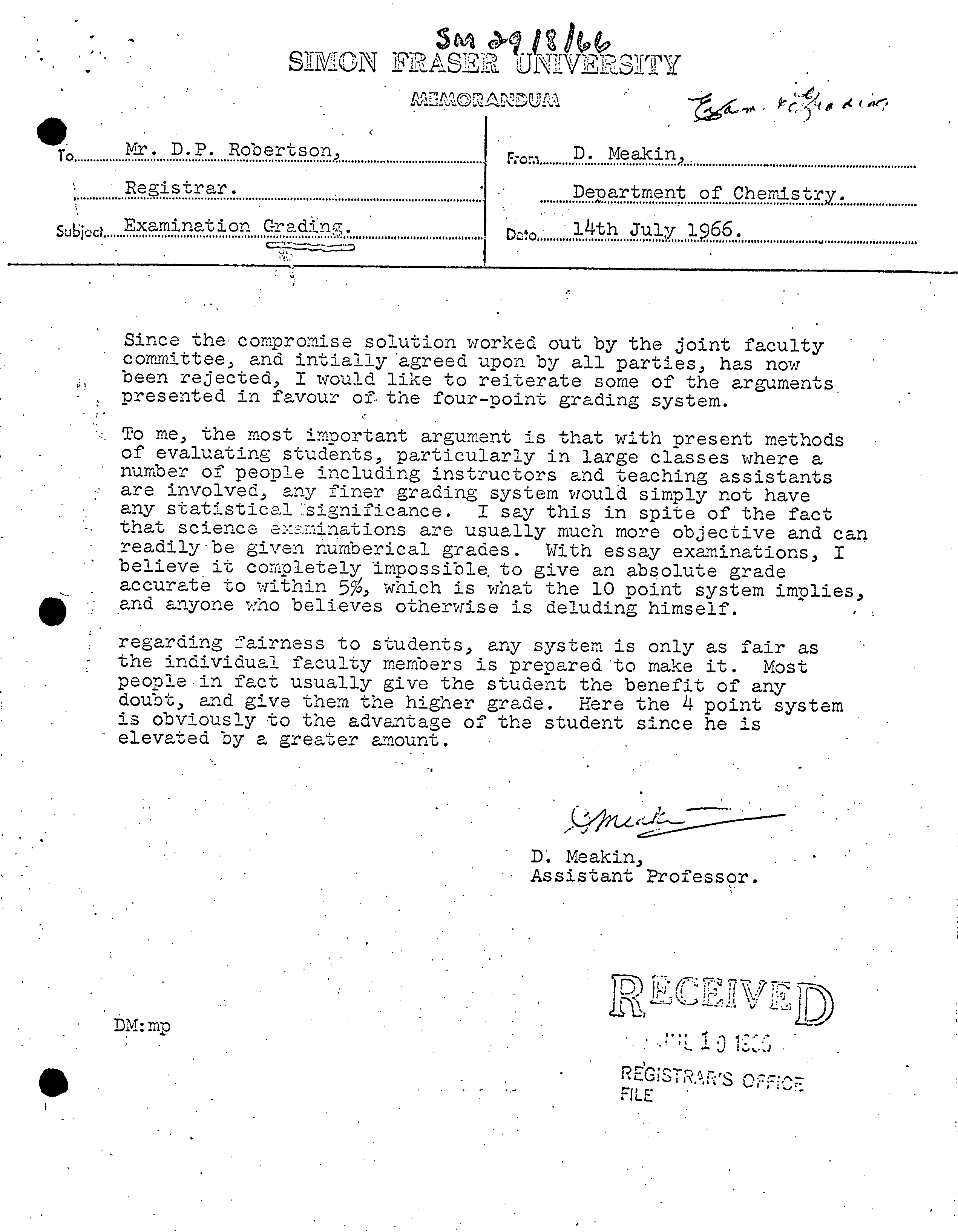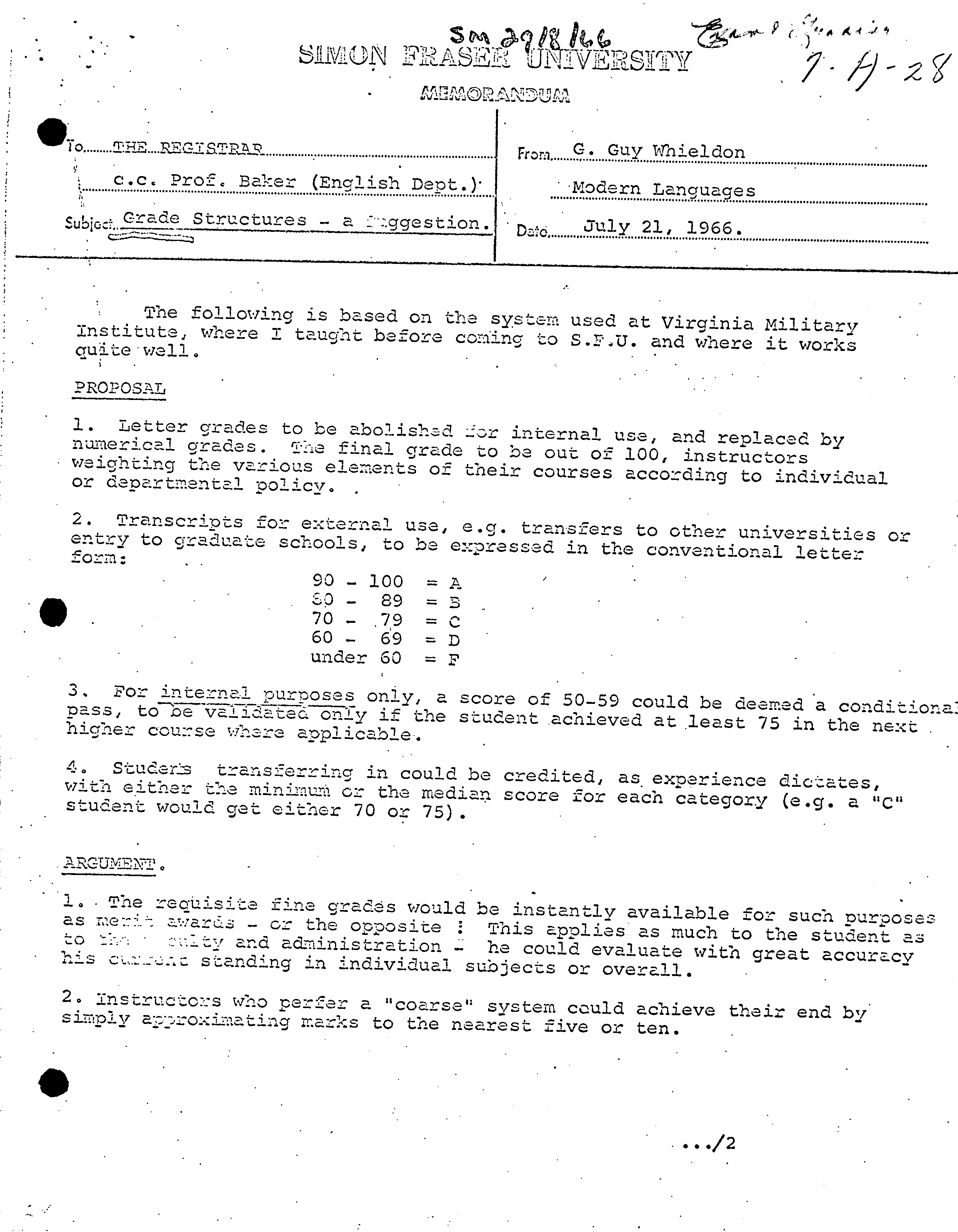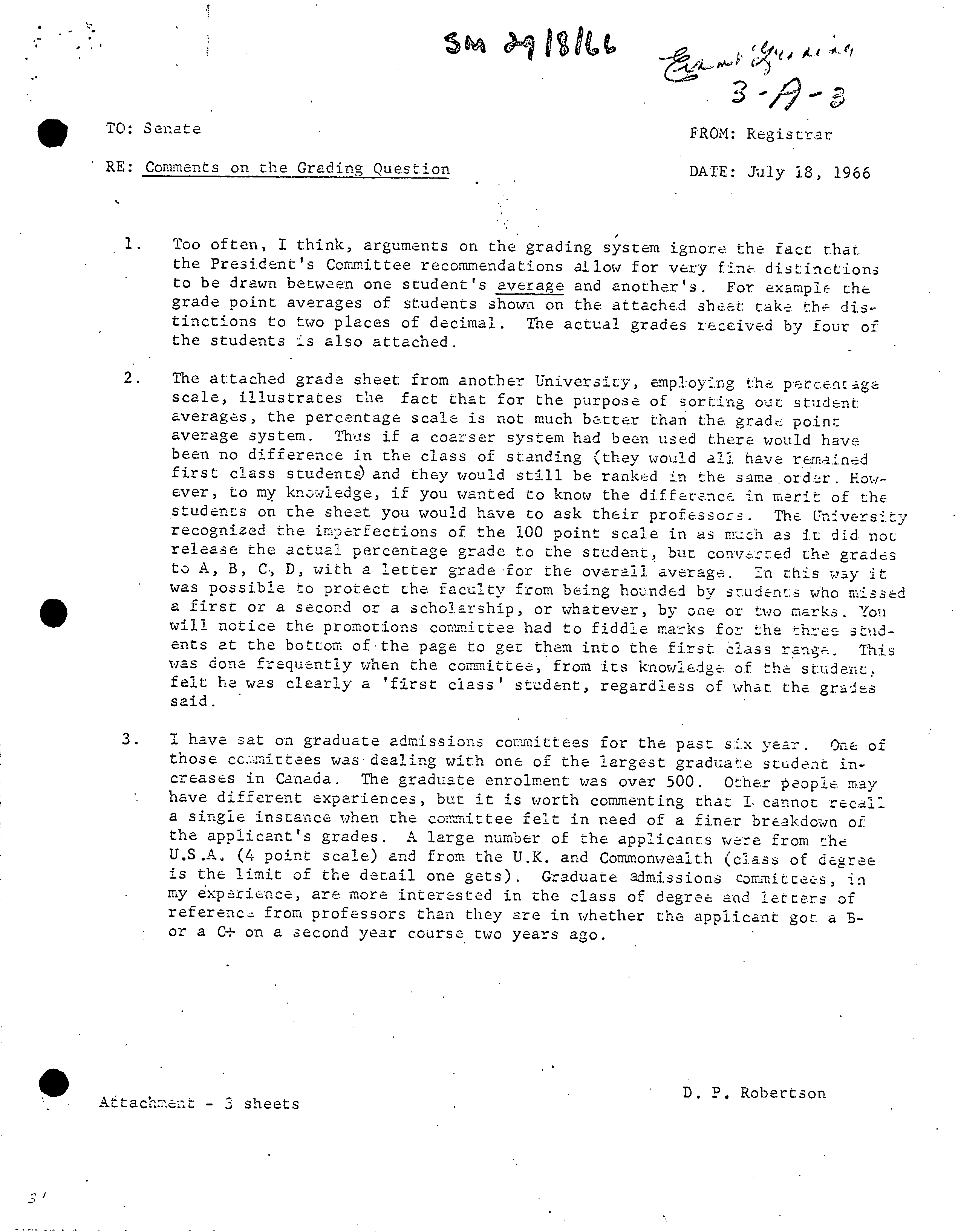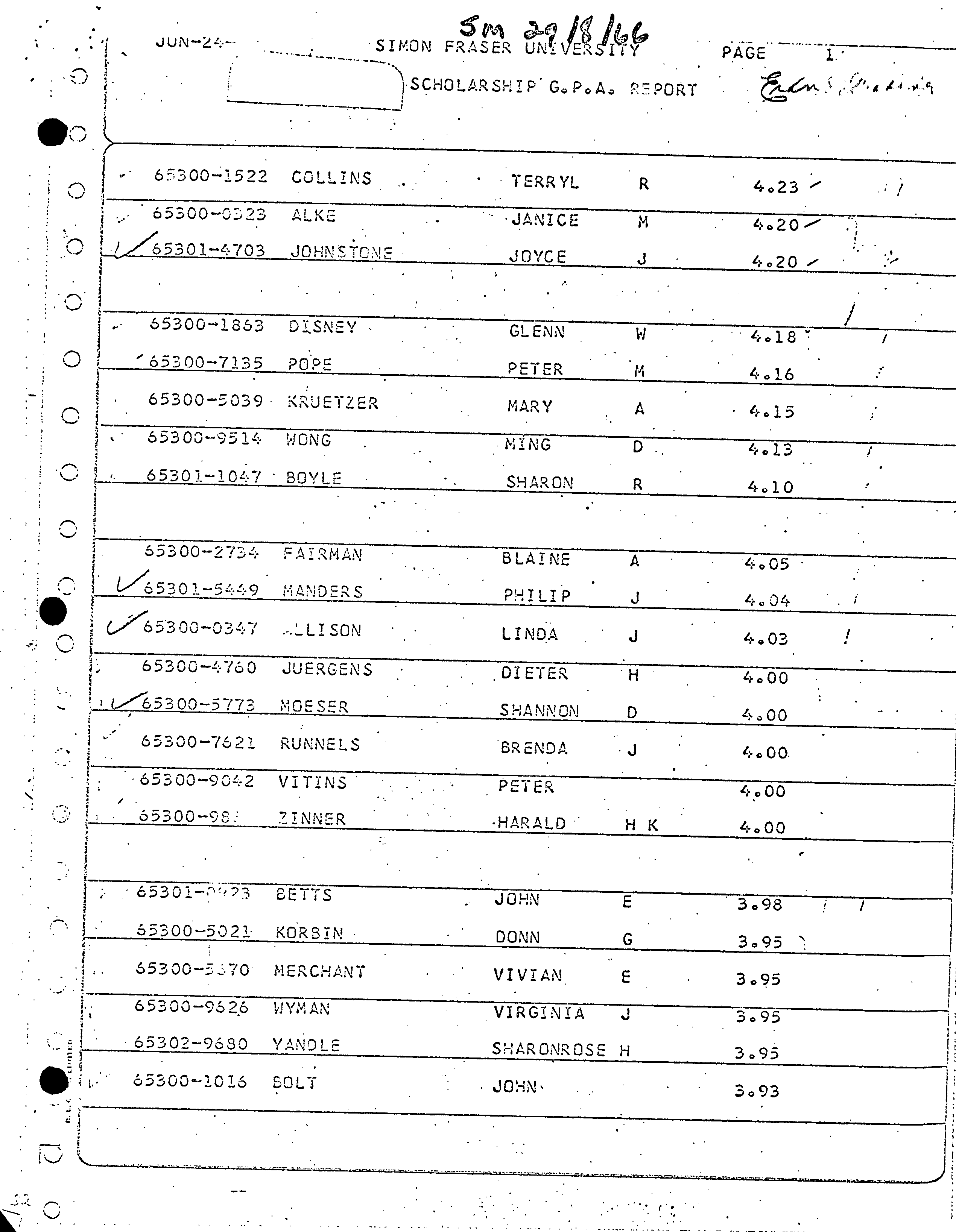i5
3.
• FROM: REGISTRAR
•
DATE: JULY 18
)
1966
The enclosed is being sent out prior to the regular agenda of Senate
so that you may have an opportunity to consider the issues raised and
discuss
them with your colleagues before the Senate meeting on August 1st, Please
• bring these papers with you to the meeting.
If there is any further information you think I may be able to supply,
please call me.
•
• •
• D. P. Robertson
• • -
•
M
S
A HISTORY OF GRADING SYSTEMS AT SThION FRASER UNIVERSITY
by D. P. Robertson
1.
On February 18, 1965, the Board of Governors acting on behalf of Senate approved
a grading system proposed by the Registrar (Norman Barton). This grading system
was published in the first volume of the University Calendar and in the revision
to that first volume. (see-History 1, attached)
2.
On December 2, 1965, the Faculty of Science approved a motion, unopposed,
recommending to Senate the adoption of a four point scale for the calculation
of averages.
3.
The Registrar, (D.P. Robertson) presented a grading system to the joint meeting
of Faculty on January 19, 1966. (see History 2)
The joint meeting accepted recommendation #2 and turned the other recommendations
down by a vote of 24 to 27.
4.
On January 24, 1966, the Senate approved the modifications to the original
is
grading system as recommended by the joint meeting of faculty for publication
in the 1966-67 Calendar. (see History 3)
5.
The President appointed a President's committee to consider and make recommen-
dations regarding grading and scholastic standings. The Registrar was named
chairman and there were two representatives recommended by each Dean. The
committee met on a number of occasions and considered numerous grading systems.
On the approval of the President the committee's report was submitted to the
three faculties. (see History 4)
The faculties of Education and Science approved the recommendations of the
Committee.
The faculty of Arts decided by a vote of 9 to 8 to submit a1ternatve
recommendations to the Senate. (see History 5)
6.
The Senate approved the recommendations of the President's committee at its
meeting of May 2, 1966.
7.
The Registrar distributed the supplement to the* Calendar (see History 6) to all
students, Secondary schools, other Canadian Universities, and the B.C. Department
of Education.
8.
On June 3, 1966, the faculty of Arts passed a motion 24 to 1 requesting the
Senate to reinstate the Grades A- and C+.
9.
On July 4, 1966, the Dean of Arts presented a paper to Senate (see History 7)
.
and the Senate voted in favour of rescinding its motion of May 2nd to approve
the President's Committee report.
July 18, 1966.
2
4
I,.
--
,-
•
HISTORY I
4
Standing and Credit
•
1.
Themark for each course will be entered on the student's
record
by a letter grade:
First Class $tani:1ing, A+, A, A-;
Sccouc
l;iss Standing,
B+,
B,
B-;
Pass Standing, C+, C;
Standing Granted, T;
Failure, F;
•
.
Special Conditions, X;
2.
The letter grade T, Standing Granted, will be entered on the
record when a student obtains a mark just short of the C grade
and when, in the opinion of the examiner, the student shoi.ild
•
not continue studies in the subject.
The student will not be
•
allowed to take further courses in the subject.
3.
The letter grade X, Special Conditions, will be entered on the
record when conditions exist which prevent the examiner from
making a standard evaluation of the student's work, e.g. when
a student, for medical or compassionate reasons, cannot write
the examination, or for medical reasons misses a large portion
of the semester.
When such a student can provide proof of
•
•
medical or compassionate reasons for his action he may be
•
granted a deferred examination, and may be granted permission
•
to write the examination in the subject when
it is
next regularly
•
scheduled, without repeating the course.
•
•
Page 75
•
•
•.••.;
Calendar Vol I 1965
•
•
• •
S . ...
:••••
July 18, 1966
HISTORY 2
'd
TO: Joint Meeting of Faculty
FROM: Registrar
SUBJECT,: Procedure tO Determine Scholarship Standings
The following is recommended for adoption as a procedure to determine
scholarship standings.
S
Elimination of the fine structure (Al-, A-, etc.). This will allow
a 4-point scale which is the scale most commonly used on the North American
continent. The Faculty of Science has recommended the elimin3ion of the
fine structure to Senate.
•
Recommendation 2
Elimination of the X grade; substitution of D for the present T:
substitution of Def. for the present D.
X -
Students will be required to file with the Registrar,
•
medical certificates, etc., to substantiate requests for
• deferred exams in cases where they failed to write for
• •. these reasons. Such requests and supporting documents
must be filed within 4 days of the date of the examth-
.ation. The Registrar will consult with the departrnert
concerned and a Def. grade may be granted. Where the
department does not wish to grant a deferred exam, an
N grade will be given.
•
T - The ambiguity associated with this grade this past semester
suggests it is not a useful grade to retain.
D - This grade is commonly used to signify the bottom of the
scale before an outright failure is recorded. It is
suggested departments may wish to stipulate that a
in a pre-requisite is an insufficient standing to all.cw
the student to carry on in the subject. A "D" grade is
• •
usually not transferrable as a credit from one institution
to another.
Recommendation 3
Adoption of a 4-point scale, grade points, and grade point average as
• follows:
S
a) Numerical values are assigned to letter grades.
•
S
.
.
• B-3)
•
•
C - 2 )
- Passing Grades
•
D-l)
F,N,Def - 0 )
S
•
•
.
•
-2-
•
.'•
- 2 -
3pd &i/
•
)
History 2 (cont'd)
b)
Grade points are assigned to each course by multiplying the
numerical value by the. semester hour value for the course.
c)
A
grade point average is computed by dividing the total
number of grade points by the total number of semester
hours.
Example
Letter Grade
Numerical Value Semester Hours Grade Point
Course
A
.
4
3
12
Course 2
A
.
4
3
12
Course 3
B
3
3
9
Course
C
2
.3
6
Course 5
C
2
3
6
15
45
Grade Point Average 45 = 3.0
15
V
This allows us to assign a meaningful, commonly used, over-all
standing for a semester without requiring specific percentage points from
the faculty.
Recommendation 4
•• .
Establish the following scale for over-all scholarship standings.
V
..
SFU Grade Point Average
First Class
3.2 - 4.0
Second Class
2.6 - 3.1
Pass
1.0 - 2.5
Recommendation 5
.
Credit for the Semester
Full-Time Students
.
V
1.
A student taking 12 semester hours or more must achieve a grade
H
point average of 1.0 to secure any credit for any course In the
semester. A student achieving less than 1.0 will be ocunted as
failing the semester; the semester hours attempted will be
added to the divisor in the cumulative grade point average, but
there will be 0 semester hours credit added to the dividend.
Part-Time Students
2. A
student taking 11 semester hours or less must achieve a grade
V
point average of 1.3 to secure any credit for any course in the
• semester. A student achieving less than 1.3 will be counted as
failing the semester; the semester hours attempted will be
added to the divisor in the cumulative grade point average, but
there will be 0 semester hours credit added to the dividend.
V)
- 3 -
History 2 (cont'd.)
- 3 -
M
Recommendation 6
Standings Required for Continuance at the University
1.
Students will be allowed to continue with a cumulative grade
point average less than 1.0 for two semesters only. If the
cumulative grade point-average
is less
than 1.0 for the third
time the student may be required to withdraw, although the
•
committee may exercise dIscretion.in those cases where the
•
current semester grade point average is 2.0 or more.
S
total number of grade points earned since
attending the University.
* Cumulative Grade Point Average = total number of semester hours attempted
since attending the University.
2.
Notwithstanding the above, students will be allowed only two
occasions where the semester grade point average is less than
1.0. On the third occasion the student may be required to
withdraw.
3. In
addition to 1 and 2 above the individual departments may
• require certain standings in their subject for major and honor
students. Failure to meet these departmental requirements ay
result in a request to withdraw from the major or honor progtar,
•
at the discretion of the department.
•
4. To be eligible for graduation the total grade points must e
equal to twice the total semester hours ever undertaken at the
University. For students who were admitted with no advanc? or
•
•
transfer credit, this means the total grade points for a Ccr!eral
Program degree must total at least 240; for an Honors prograr
degree, at least 272. In both cases the cumulative grade point •
•
average on graduation must be at least 2.0.
•
•
S
•
S
•
S.
S
History.2 (cont'd.)
- 4 -
.
Attachment to Recommendation for Procedure to Determine Scholarship
Standings
Examples
..
Recommendation 5, Item
'l
.'
'. Numerical
Semester
Grade
Example 1
Letter Grade
Value
Hours
Point
Course 1
D
1
3
3
2
D
1
3
3
3
D
1
3
3
4
D
1
3
.
3
5
.D
1.
3
3
15'
15
•
•
Grade Point Average 15
1.0
•
•
15
Student retains credit for all courses - earns total of 15 semester
hours credit.
Numerical
Semester
Grade
•
Example 2
Letter Grade
Value_
Hours_ Point
Course
D
•
1
3
3.
2
D
1
3
3
3
D.
•
1
3
3
4
D
1
3
3
.5
F
.
.
0
•
3
3
15
12
•
•
Grade Point Average 12
=
.8
15
Student receives no credit for. any courses
—
earns total of 0
• .
semester hours credit.
•
S
.
•
.
•
•
:.
.
:
•
•
0 .
•
.
.
.
.
.
I
SA
L
History 2 (cont'd.)
- 5
Recomm.datjon 5, Item 2
Numerical
Semester
Grade
Example 1
Letter
Grade
Value
. Hours
Point
• Coursél
C
2
3
6
2
C
2
3
6
. 3
F
.0
3
0
.9
12
•
.
Grade Point Average 12
= 1.3
9
Student retains
credit
for courses passed -
earns total of
6
semester hours
credit.
Numerical
Semester
Grade
Example 2
Letter Grade
Value
Hours -
Point
Course
.0
2
3
•6
•
.2
D
1
•
3
3
•
.
3
p
0
.
3
0
9
9
•
Grade Point Average 9
=
1.0
Student receives no credit for
any courses -
earns total
of 0
semester hours credit.
• .,
•
•
i•
•;
.
.;
•
•
•
•
?dP
i'A
i-'-
History 2 (cont'd
)
- 6 -
Recommendation 6, Item i
Semester 1
Semester 2
Semester 3
C
••
C
D
C
D
F
C
F
F
C
•
F_
F
F
Grade Point
0
0
1.6
Average
Cumulative Grade
0
0
.5
May be required
Point Average
(on probation)
to withdraw for reason
of 3 consecutive occasions
where cumulative C.P.A.
• less than I
...
•.
'•
If semester 3 had
been
C
C
C.
C
G.P.A.
2.0
'Cum
C.P.A.
.7
the
cumulative C.P.A. would
still
be less than 1.0
but
the semester C.P.A. of 2.0
would indicate to
the
committee that the student
is picking up and
could be allowed to continue.
.
July 18, 1966.
f•.
M
HISTORY 3
Standing and Credit
.
i.
The
mark for each course will be entered on the student's
•
record by a letter grade:
•
First Class Standing,
A+, A, A-
Second Class Standing, B+, B, B-
•
Pass Standing, C+, C, D
Failure, F
•
Deferred, Def.
Did Not Write, N
A)
The letter grade, Def., will be given when a physician's
certificate or other document substantiating a request for
a deferment on medical or compassionate grounds is received
•
•
by the Registrar within four days of the date on which the
examination was to have been written and when such deferment
•
•
•
is agreed to by the instructor involved.
•
b)
The letter grade N is given when a student registered for 'a
•
•
:
course and did not write the examination and did not with-
draw before the set date.
An N is considered an F for
• •
purposes of scholastic standing.
1966-67
•
.•
•
:
•
Calendar Vol II
•
•
•
• July 18,
1966. •
S••
•
•;
.•
•
HISTORY4
President's Committee on Examination Grading and Scholastic Standings
PROPOSED GRADING SYSTEM AT SFU
A. Grading Scale -
S
Letter Grade
Pts. for Internal Use
Pts. for External Use
S..
A+
4.5
4.0
A
4.0
4.0
•
B-f.
3.5
3.0
B
3.0
3.0
B-
.•
2.5
3.0
C
2.0
2.0
• C-
1.5
20
D
1.0
1.0
F
Def.*
Instructors would submit
vert to Columns 2 and 3.
of marks. Column 2 would
ship and Awards Committe
the four categories used
0
0
O
0
0
0
letter grades from Column 1. The Registrar would con-
Columns 1 and 3 would appear on the student's statement
be a "private" calculation to provide to the SFU Scholar-
a each semester a list which makes finer distinctions than
in Column 3.
Questions:
(a) Why not just use Column 2? The Committee was of the opinion that the use of
Column 2 "inside and Column 3 "outside" satisfied both sides on the contro-
versy over the degree of exactitude possible in marking. And, it does no
damage to the student if all faculty strive to use the full range of grades
available knowing that the fine structure of grade points is only for internal
purposes.
*
The letter grade, Def., will be given when a physician's certificate or other
document substantiating a request for a deferment on medical or compassionate
grounds is received by the Registrar within four days of the date on which the
examination was to have been written and when such deferment is agreed to by
the instructor involved. The Def. grade may be removed when a new grade is
established; the method Of establishing the new grade is a matter between the
instructor and the Registrar.
•
** The letter grade N is given when a student registered for a course and did not
write the examination and did not withdraw before the set date. An N is con-
sidered an F for purposes of scholastic standing.
-2-
Ritory 4 (corit'd.)
5.
3iH/4
K
rçi7)
While some fine structure is essential for the purposes of the Scholar-
ship and Awards Committee the four point scale is certainly the most
commonly used in North America and there appears to be some virtue in
helping our students to appear reasonably "normal" on their transcripts.
(b) Will it not be puzzling, to studnts as well as others, if a man with
5(A+) comes out with the same grade points as a man with 5(A)?
To some degree, it may be puzzling, but no more so than that the very
•
same thing occurs under every conceivable system of grading except per-
centage points or some similar ultra-fine.-structure. All this proposal
does is draw attention to this possibility and give a lift to the student
with 5(A+) which would not be possible with mere A's. In addition, the
man with 5(A+) does appear ahead of the man with 5(A) on the Scholarship
list.
B. A grade point average is computed by the Registrar by dividing the total
number of grade points by the total number of semester hours.
Example:
Numerical
Semester
Letter Grade
_Value
Hours
Grade Point
Course
A
4
3
12
Course
A+
4
3
12
• Course3
B-
3
3
9
Course
C
2
3
6
Course
5
F
0
4
0
16
39
Grade Point Average 39 = 2.44
C.
Standings for the Semester
16
The Committee recommends that no rigid determination be made of the grade point
average required for First Class, Second Class and Pass Standing at this time.
The Committee recommends that for the time being the Scholarship and Awards
Committee determine for its own purposes and for the purposes of government
awards what the cut-off points are for each semester.
D.
Credit for the Semester
The Committee recommends that any semester hours credit gained by granted to the
student regardless of the standing in the course, or number of courses passed, or
the grade point average.
E.
Standings required for continuance at the University
The Committee recommends that students receiving a grade point average less
than 2.0 be placed on "probation" and that further action to be taken in such
cases be determined by the Senate Committee on Admissions and Standings.
- 3 -
/I ':-'
3
History 4 (Cont'd..)
F. Standings Required for Graduation
The Committee recommends that the minimum requirement for graduation be a
grade point average of 2.0 computed on the courses used for credit towards
the degree, and in addition there may be further requirements established
by departments for their major and honors program.
- C. The Committee was asked by the Committee of Heads to make a recommendation
regarding the re-writing of papers. The Committee recommends that, except
in the case of a Def. grade, a student not be allowed to re-write (or write,
in the case of receiving an N grade) a paper unless he re-registers for the
course and participates in the course as required by the instructor.
Respectfully submitted,
•
C. L. Bursill-Hall. (Sub.B.E. Newton
- Arts)
P. Copes - Arts
R.J.C. Harper - Education
K. E. Rieckhoff - Science
• •
D. P. Robertson - Chairman (Registrar,
•
.•
S. Stratton - Education
•
D. C. Tuck - Science
July 18, 1966.
•
•
I..?
'A4
q(c /
k
HISTORY 5
TO:
Senate
FROM: Faculty of Arts
PROPOSED AMENDMENTS TO THE GRADING SYSTEM PROPOSED BY THE PRESIDENT'S COMMITTEE
ON EXAMINATION GRADING AND SCHOLASTIC STANDING.
Amendment 1: It is proposed that Columns I and 2 of the Committee's proposal be
changed to read as follows:
.
S
Letter Grade
Pts. for
Internal Use
4.33
(or
4.3)
A
4.0
•
A-
3.66
(or
3.7)
B4
F
3.33
(or
3.3)
B
3.0
B-
2.66
(or 2.7)
OF
2.33
(or
2.3)
C
2.0
C-
1.66
(or
1.7)
1.33
(or
1.3)
D
1.0
D-
0.66
(or 0.7)
F
0
Def*
0
**
0
*
The letter grade, Def., will be given when a physician's certificate or other
document substantiating a request for a deferment
,
on medical or compassionate
grounds is received by the Instructor within four days of the date on which
the examination was to have been written. The Def. grade may be removed when
new grade is established; the method of establishing the new grade is a
matter between the instructor and the Registrar.
** The letter grade N is given when a student registered for a course arid did not
write the examination and did not withdraw before the set date. An N is con-
sidered an F forprposes of scholastic standing.
Amendment 2: Add the letter grade I (Incomplete) to Column I, making it a grade
to be given at the discretion of the teacher and to be converted
automatically into an F (by the Reistrar) after an allotted period
of time.
(Passed by the Facul
t
y of Arts at its meeting of April 21, 1966).
July 18, 1966.
I
V
H
H
H
C)
1-4'
1-'
P-I
H
H
I-
•
I-'
P-3
C)
)
1 '
fl O'
1-1
>
to H .
rt co
C
0
C)
CD
C)(D
a
M A)OC
P1
D
C)
D)
1
P
OC
p.
D
0-
OCp
0i
J(D
r
HC
p-C
D
0
p
-'r-r
ci
j---'
ci
Ct.
C
C
0 P
C') CD-. H
. P1 0-
0
D)
CD C)
0-
rt
0-
CD
p-
CI)
P-h
i-
ci
p.s.
ci
rt
Ch
CD
5
Z
ri-
0
CD
CD
0-
()
H.
CD. p - ..
rtOCD(DC)CD
0 w
W- (D
p-.
(DCDQ..r-.)
p
W.
iDci
ci
O
P1Pjr
0 0
S<0
CI0
0
ci i
CD
Cci
Op-.
C)
OQCI
Q
QCD.
P-i-c
C'-.
CD '.
C
pc.
5
0 H.
ci
P-'-
0
00
I-h
C)
—
P-
rCD0
CC'
p-.-
.
()r?
D)
C
(n
D
C
r5
OP-I
lCD
0-
rt
ti
•
0 CD
CD
C)
0-
W. P-
i
- P1
C)
O
CD
M.
ci
ED
0 p
P-hrt
CD
1)Pj
rP<Orrø
C
•
• 0(
C
)
I-
P-h
hrPCD
'1
CD
'1
0
(CI
CDCDO
C)
ci
P--
CD.< C)
0.
ci
'
p-
C
.
C
)CD<
H.
'1
H.
'
0
0 ci
CD
Ct
C)
)
•
P4
C)
p-.
0
0
I-Pc
'0
P1 ci
C
CD C
ci
W.
(t)
P-. CD
(I)
•
0
0p-..C1-hQ0
gopi
23 H.
ra
co .0
0-
CD
<CI)
CDOp-.
P11-4
P-CP1CDO')r4
00CD0')
ci
ci
lb
p-i
W
I-C-i
•
'0 CD
llrrCI
0-
)
CO.
rt
S
CDP
CD
I(CICD
S
CD •
CD
5
CI)
0
C) p-'•
C)
CD
C-
•
C
CS(DC
CDP-PcCLOCD
> 03
Cl)
ci
<I--
rr
•
• '<
O I--'
'0
1-1
CD
0 rp
CI)
CD
0.
rP
C
cir
-'
p
r
.
Hi
ci
5(
0. Cl
D
)
j(t
ri
r
-
C
C
C)
CD
i-C
P-
i' (C
H
I
CD
pi
•
CD
0
ci
CD
1-' •
C')
ci
ts3
pi.
C
P1 CD
0
CI)
C
ri-CI)
CD
' cS
CD(
oci
D
p
0.
- hr
(D
r
2
t.
QO
I-ic
CICn-c--rI)CD
—
ci
(D
C
•
CD
C).
I-h
(I)
CD
II
PiI
-
ci
-.
i-'-
(')
.
CI
H.
CI)OrtC)
CI)
0P-CDci'0
P-hP-I
ci
•
(D
Cf0
ra
.
P1
ci
P1(Dr
I.-
PS
(D
'p
r
n(
-.P
(D
1
I)
P
C
5C
D
1o
.0
0
P
Q
I
1
to
m
u-
'ICC
co
IO
H. CI) )
0)
ci
H.
o
CI)
CD
'0
p-i- CD
ci
C
'0
Cc.
g'-c
p-' ci
C)
ci (CI
0,
• ciC
P1CDCI
Sp-'.rtCC
0.rrrr
CD
30-
CD
0
(1)5
CI)P1rrCI)
Cl)CDp-.0CI
CD-
•
•.
.
<0-rtC
L..CDCDCDrP
rtCDO
<
CD
I--
i.
p- -CDr
OS
0-p-i.
CI)h-
CD
,
(nil
H
0-0')
H. CA
CD
II
(1)
CD.
0
0.
i-. ci
Ct) (CI
H
(DP1C)CD
0 CDO
0-(DrtHC)
0-CD
CD
(DO
P-h
P10rC0-,0QP1
p-'.
.0-0 c-G
CD
'
'S
CD
cr.
P-C
CD
rtc/)
.0') w cr w
riO.
CD
S
CO
(D
(D (D
Ct)P-
P1
0'0
(D
CI)
•
CD
P-lCD
CD
rt Cn t (D
0
CD
rtrC-
co
• C)
•
I
'0
P--CD
0
0
cn
CS)
•
(D(Di-'''
p.•p-i
CDI--'Cfl
'
I1.
CD
I
Cl)
G'r pp -)
p.AC)
-J
--
<CDCDO
CD(D
(DP10'CD
.•
C)
(D--0'
03 (D
CD
H.
P I
0
Cl)
vi
r-
CD
CDCDCI
P(nCI)Ci
CD
t1
0-00')
0-Srt
P1
CI3C
CDCI
J) (D
)
2)
M O
in,
(D
CD
P-
Q
CD.
CI)
rrp
CD.p-
-.
HcG')'0
CI)
H
0
i
'0P1 P
I
)p--P1'0
03(DCD
'<FC-CDD)P1
H
•
p-CI)0-O
•
C!)
CD.
•
U)P1
Ortp
-
.<
OQ0)
•
,
•
'.fP
I-'-
O
CD
O' 0QQ0-
%M
H,
c•
rP po
-JCD'1
'0
cicnoo
P10
CI)OO
0
CD
rtCI
C\
I
p-I
<
CI
'
I-I-i
ci
D
0
I-'
C'
Pi
(D
CD.
CI)
CD
(DP)
ci
1-4
•
•
rtri
CD
-
.
CD
rr
CI)
,'
C)
•
H
C!)
U)
0'
0
•
CD
H.
0-..
•
'CD
I-Pc
0-'.
,
'
t
H
C'
ci
•
0
H
C,)
H
0
C'
S
I
0
(:4
CD
-1
03
4-.
CD..
CO
C
4-
03.
C?
I-..
0
(A
(0
4-
0.
P3
0)P,
rr
I I
I
r?
-\
- • or)
'IOCDOCDrp
rP3pj
(.Jrt CD
-•
cr
1
0
0
0.
cf.
00
rr
0
t)
.
CCD
,i
'1
11Bo.c
<
i-'
p-.
rr
P-h
Pj
',c
CD
.
'1
?
CD
x
0CD(i
'i
B
ID
•
coC.
CD
.3
0)
(:4
0
1-
I I
p-.
4- rt
i-p
C?
4-i.
0
CD i-
a
0 0.
q,
C' 0.
OCD 10
P)
C? - CD
0cI)-
P-ti
0
Cl)
P1C
0
C?:.C,l
0
H
.
0
3
(.
(
(i()
r0(D
0Gi1r
CDC.)
C'<
rT
co
4-
0. 0
Cl)
-•o
'1
(DB
)-.(D
'1rprt
•
0
coii
ra
•
H.
(:4•Q
•
-
CD
Cr(DCD
CD
'IBO.
C'
P1
CD C
•)
''r•
CDr
C
.
i-rB
s11'rpp...O
<
1.)
CD
C..
rr
orr
P-n
P3 - P CD
00.rrC(D
0 C C?
rfl)
'1OCDPI0.P3
CD
01
C1()
r? (D
o
C
0)0
0C
BID
P -n
(0.
co
r-P3p-..
CDIDP1
c-to
0P3,,-CD
CQ.
0-..
.•
?'1 frP-pJ
?-.Cre-'.P3
CD
'1CD.
rr
(DO
C
'1CDp-..-p
Cl)
.
r1-p.
CD
-ca
P-$P1P3.
0'
P3
•
Crr<4
Cl)
Cr
'-
0
i
(D CD
P3CDCD
BID
010
-oo
c-p
-nCD
-.•
r?
CD0.p-.
(D
CT
•
rr
C 6
CD
CD
ri
c-p
ri
Op.
CD
0 )(D
01
O
o
CD
•
P-t
P1
0)
'
•
.
0CD411C?
'10
c
P30Cr,11P3
lB
I,z
ro
1
0
I
CCQ
CC)
00(0'1r-p
C
'(D0Cl)P3
'1p-..c
•'1I'110.
P30)
CCI)'1'1Q)C)
(0
c-P
1GO(D(D
CD
Z3
.rt
00)0)P-'•0CD
co
co
(DB.P31rr
0.
CD
CD
C?
X
Cr
CD
P3 '1
•
C)
'1
Cn
0
Cfl.
C)
i-
.
'.
0
IDI
'1
H.
H.
B
A)
• j
-
.
H.
0 A) I)
Cr
p-.
co p. '1 CD rr
i-
(0
C).
W
co
P-'.P1C/D
0
0
0)
000000
C..
C
0.01
< X
0)
•1P-t'<Cr
p-A)•
o
-S
P1
0.0.10
(0
0
00
A).0
'101
c-v
p-.
0.
0)
0
ii
00P3CrCC
0.
11
'1
^:3
C
0001
c-i
M M
CD
(l)P-'
P-'
0
:>
'-
rr
o
0C
W.
D0.'1(DCOS
(
C
D
..
-.tCo0o01
C
Cr
D0'
rr
'.
(I
Z
)
(0(DZ1Co
rrrruv
11
P
p.
rPr?(D..
'1100
CD
C..
0
Co
CD
I
CD;
w
-Cl)
I-n
B
i-n
0)
0
03
0)
X
P1
0'0riO,
0
CcpC)
CD 0
c-i
m
(0
x
P1 0
' . <
P
. -'
CD
10
CD
'
rPrlrrrrD3
0)
Cr
COCOCOC)
CD
i-'I-1,
0.0
P10.p-.
0
r?
'1B
CDC?CDCDrt
0
CD-(0(0
.
4-CD
p - ..
CDXA)BB(0
0.
CD
'1
(0
.03.-rra
0
k4
0010)
0
B0.0)
0(00.
CO
CC).
P1
W
Op-'.
CD
<CI)00'lOc-i-
o
C-(D(D0
0r-.4-.rr'r?r?.-
0.0'1<
0
p-'0 0)O
'1P 3 00'1'1
0001
•
0)
C?00
t.
0'
-h
(0. Co
c-v
.
9D
(n
CD
c-v
t ,.
•
CD
•
lb
(D
'1Qg
CD?0'Q.CD
.000)
P1
Cr0)
C)
Cr
'l'l p -.
Cr
03
CDCDr1O0'
-rj<p -
rp
(Or?
Cr .
C
CD
CD
P1
P-h
03 (
C
i-
CD
0
••
C..
Cr
0'
:o-
(0 0
i-
0)
•
'1
•
0O
'0
ca
H.
CD
En
p.-
-
p
'
-'.
Cr
H.
Cr
CD
Cr
0)
CDO
4-
Back to top
o.00'
.r
p-..
?C
'0
0
O
C
0.0)
CO
D
C
0)
CD
0'
(0
C
co
)0)
0P
B
rlr
'0
3
r
Cl)
CD
CD
Cr01
00
(0
11Cr
0CD'(D
C? .0
•
(1)
Cr'1
•
0p-.rrp,0
4-.0
000.0)
(000.
.
H.
c-v
I-' .
P-ti
C?
0
t•..
CD
Cr0Q
p...
CDCD0'
(p-'.0
II
0P3
0)
p
--'
.
Cr 3C
CD
C?P0)
0
1-.CrCD0.
4-'
01
0.030
(Or?
Z
CD
0
(0
CD
C
P1i
(Op-'.rl
(4
(D
CD
C
01
CD
CD
I
(1)
0.
2
*•
CD
C
0.0.'
l) 0.f
1(
rf))
0
-
4-
P
p .C
'
.
C
Cr
B
D
1Q
4-
:
Cr
i
C
.'
4-
00'
4-
o
P3
.
CD
0G
Cr
P-n'
.0(
C
0C
1
Cl
D
C
)
)
'
p
Cr
l
CD
C
-
D
5
04-'.CtI
Cr4-.-'
CD (0 0'0'4-iD0co(00. 4-dID
0.Cr
0
0C
Cr
r
(1) C
Cr
D
C?
P
C?
p.
pi
.
Cl
0)
.
P
0
-hp-
C)
'.r
Cr
r
0)C(0 C?OOC?0)4-.'1P3CD
CDIDP-ti
CrCr(1)
Cr4-I
Cr0)
10(0
0.CDCD
0.(D
IXJ
i-'I-tiCD
1
CD
00
(0.
'1
B
CDCP-
P-hCOP-1DO'1
4-
0P
tiP
3Q
i 030)
.
CD
Cr
C?
C?
C?
Cr
P1
'1
CO
'1O
o
CD'
un
1
(D
c
PI
C.
0)
010
0
P1CDO1
<(DC?
'IC
CD
C
'1
C
i-
D
p
- ..
CD GQ
0' (0
0' (0.
Cr
CD P1
tiQ.
-'.
000
'1
: C
B
p...
#I ftj
'00
Ci)
0P1
01C
CD
01
o0o
r
Cr p
<
.
g
'.
Cr
CDr
03
-
p
r
-
CD'
t1
I-
Cr
.
CD
-
C?
T(
Cr
D
B
C
0
Op
,-
-
.
r-
'.
'
o
0o
P3P1P3PI0QP-..CDCD0.B
0'
'io
Pi
-•
01Cr
.
CrCDP3Cr
0
Ir
Cl
C
)
C
?
D C
Cr
D
CD
4-
CD
C5
.
(
C
0.
-
r
'-
P
.
Cr
'(D
I-
I t1
'.
0p-
'
B
0)
..
00
0)
p-.
O
-
C
Cl
<
) p00 .'.
4-A3CD0) COlD 0'01 p
.'P.
Cl)
CO
03C
CDCDc
r
n
r? H.
(Dc-
C
P
9
r1c-rP3(Orr
O
Cr
- •
. >
BC.
P
<
3C
Cr
.
....CDC
r?
OCOC
0
C
'
0D
c
.'P134-.O
.0Cr(0
p .'.CD
11L.rv
CrCr0D0)
c-v
P3rr.
o
(DCDCAp-'.p-p-..
CrC? i
H .
coo
o.n
'- c-
0g
P1
(003 .
P1
0109
Cr4-.0O p
0C
- p 1 P3
rP)Q
'<
).
0000)
• O
I
0.C
C
ci
D
II
)
r
100)
•
01
0303
C0
C
'1030
DP
O
i.B
(D<
Cl)
(
P3
DC
r
0)
..
(0
'I
i
C
4-.
)
.
CD
C)O.•
<
0..
is
(1)
w
000O
P3
CO CO C
CO
Cl)
B
4-
CD
C)
'1C)-.
'10
'1
P3
0.r,
CDCD
(:4
0
p-.
Cr
H
>
O)c..4:'.4:
C
CD
•
<
(Dri
CD
t'.)
,
I-.
C)
•
(.3
.
P3
-
CO
.
-
•-'
CD-.
•
.
•
'-4
0•
C
1
CD
0)01
Cr
CD
P1
l
0
0•
Cr 0'
C?
CO
<C.
C .
B -
CD
0'
g
0
'1
Cr rr
0 CD
411
CD P3
Cl)
c-rID
(0'i
B.
c-v P3
CD
0) ?
- '
(0
Cr
'ICO
0(0
Cr
C
r
1
(0
(1)0
• Ih0)
(0
COB
• 'l ID
•
0) CO
0. c-v
CDCD
I-i
•0
0 .
P- .
(fl
c-rn
B
'<C
•
c-p
c-rID
CD
08
p-.
Cl)
CO
•
p.3
p-'. C) l-%C)
(:4(0
1
4-44-1
A)
Z
Cr
C)
()O
;z .. ;o
.
CDB
i-..
4-
+
0C C.)
C
030)
.0
C? P1
•00
co
C -
co a
.0
4-'C1)
C/)
<
PII
C)
C)
i-riO)
A)uO
03
pi
CA
P-'CD'I
I-.
1j
()p-'.
(DC)
(0
CC
A)C
P-I
Cr00
Cr110)
p.3.
p.'.
.
C)
• 0.0
C
C
000
. '1
080'
- A)
,)
4-"<O
0.0
4- .
0
Cr1010
•
(DP3C
P3,.
P3
•
(06
'1
CD.
(0
Cl)
p -
.
0
'1
C)C)
A)Co(D
4-4)4-IA)
•
•
c-i
(0
•
I-'
rt
(OP-ti
'1
C 0
CD
•
C).
s-'
(000
p.-'
(0
'003(0
P303
00.
•
o'IDC?
,- . .(D(D
•
(:4
4-.
C
C
COO
•.-'
Cr(.)Cr
'l'I
C
(0
.•
(0 P301•
0.
4-1
•
*
03
(0
•
C(D
**
(1)0)0.
•C
(0
0.Cr<
•
CO
(00'
t
4)
P-
0C
B
C
•.
0.
Crt)
- CD
Cr
0'lC
0,.
0
ICD
(1)
•
C
-
•
CD
x
Ct
I
-
.
•
•. . -=,. .-•--j.
ft
;.
HISTORY
m
7
TO: SENATE
FROM: DEAN OF ARTS
June 22, 1966
RE:
'.
ARTS FACULTY REQUEST FOR MODIFICATION OF THE GRADING SYSTEM
1.
At a recent meeting, the Faculty was notified by me of the Senate's accept-
ance of the Grading .
System proposed by the. President's Committee which was
specially set up to make recommendations on this subject.
2.
The Faculty had already expressed, by a marginal vote (9 to 8), its preference
for-a more detailed Grading System, and a correspondingly more detailed system
of numerical equivalents. This preference was considered, but over-ruled, in
the Senate meeting referred to in (1) above, which adopted the recommendations
of the President's Committee.
3.
When it was notified by me of the Senate's decision, the Faculty entered into
a further discussion of the Grading System, and by a vote of 25 to 1 urged
Senate to reintroduce the alphabetical grades of A- and C+. The Arts Faculty
was otherwise ready to accept the details of the Grading System adopted by
Senate.
4.
If we consider the recent comparative study of student grades made by Charles
Hamilton, the difficulty.of interpreting broad grades (A, B, C, D etc.) be-
comes immediately apparent. It exaggerates the gulf between B and C perf or-
mances by omitting the simple fact that many of the B's probably verged to-
wards B-, while many C's verged towards C+. In short, most students in a
course may really have fallen in an unseen, because unrecognized, category
which came between B and C.
5.
The Faculty of Arts felt that the omission of A- and C+ was particularly un-
fortunate because these are perhaps the most critically useful grades: C-i-
might even be the most used grade.
.
6.
The awarding of scholarships, bursaries, etc. frequently requires some fine
distinction to be made between candidates who are in many other respects of
almost identical achievement.
7.
In conclusion, the Arts Faculty feels that the top grade of A and the much-
used grade of C badly require sub-divisions. An unqualified A (M- was thought
to be a contradiction rather than a qualification) will inhibit its user in the
many instances when a student's work attains some A quality without being
squarely A throughout: an unqualified C will produce similar difficulties for
themarker, thus lumping together students who almost made a B grade with students
who did really poorly.
[IJ
0
- 2 -
S
History 7 (Cont'd.)
Scale AdoDted
A
A
A..
A-
B
B-.
B
B-
C
C-
C+
D
' C-
F'
D
Def
N
F
Def.
N
A.B. Cunningham
Chairman
July18, 1966.
S
Mbq
...
TO: SENATE
FROM: REGISTRAR
RE:
GRADING
DATE: JULY 18, 1966
.The-attached memoranda were among those-received by me following a
request to all faculty for an expression of opinion on the Grading question.
D. P. Robertson
Attached — 5 memoranda
17
S
SItMON FJFASER
\i
•
1EGIST1A5 OF'
From.
Registrar
.
Economics and Commerce Department.
Dato .......
Jul
7............
/ IL/
:ii
In response to your memorandum
'
of July 11th, I am attaching a
copy of a memorandum I prepared some months ago. I feel, it
is still relevant.'
A few additional comments are, perhaps, in order. An important
consideration is, I believe, that a grading system should provide
for the maximum degree of realistic
discrimination
amongst the
results of students. The fact that the system I propose allows for.
open
a
d
iscrilnination.by
class
interval at
intervals
the top
of
where
f
ive
there
percentage
are few
points(
students)
with
is
an
sigr'icant here. A simple percentage point grading system is
unrealistic in that few markers can really discriminate between
results that are only one percentage point apart: But I believe
that most markers can
distinguish
results that are five percentage
points apart. In other words, while we cannot distinguish properly
between results of 72 and 73 per cent, we can between 72 and 77
per cent. Of course, there will always be borderline cases between
any two grades. This is a difficulty that no grading system can
circumvent. But in a finer grading system the consequences of
misPlacing a student by one grade are not so severe. There is not
that much difference between a D and a P- or between a B- and a
C+. In a coarser grading system the consequences of misplacing a
student by one grade are much more severe. It matters a great deal
•
, . . whether a student gets a second class (B) or pass (C).
A major advantage of a finer grading system is that it provides, for
a much more accurate calculation of the average results for a
student over a year or over his university career. In a coarse grading
• S
•
system it is quite common for a student of lower performance to come
up with a higher average than a student of higher performance. For
instance, a student who makes consistently a high B will show a lower
- average than a more erratic student who usually rates only a low B
but gets a single A somewhere in his record. This cannot happen
if a high B student is always credited with a B+ mark and a low B
student with a B-. .
Finally, I should like to riterate the point I made previously that
the system I have proposed is easily reconciled with or converted to
almost any one of the other grading systems commonly n use. (See the
table in my memorandum of January 27th.) .
TZ I
I
SAA
-
E'iON FLASE, UNIVER"ITY
S
O)Lg
I "
S
RLcISTR
Il3 (
• To
ggQçai,Dean,
.
•
•t,pfEconomicsandCoerce
• SUC
/
I would like to suggest the adoption of a grading scale shown in the
•
left hand column of the table below. Its advantage, as I see it, is
that it can be reconciled with, and converted to, almost any one of the
.
•
other systems coonly used. Comparisons are shown in the table below..
A+.
First-class
A
. 85+.
A
11.5
11
'..
A
80-84
A-
4
B I
-
•
75_79
••. 3.5
s.
•. B
Second. class
B
'70-711
B
3
.3
1
B-
65-69
B-
2.5
C+
60611
C+
2
2
•
C
Pass
:
'
5559
C
'. 1.5
— — — — — - - -
D
D
50-54
D
1
1
•
.
1 .
Fail
.
P.
under
F
0:•
Note I have just received an alternative proposal by Dr. Evans which
•
•.
has been sent out to Department Heads. While it is close .to the proposal
• put forward in this memorandum, it differs in that it has one category
less in.the second class and uses minor symbols rather than plus symbols.
S.
:
I feel the extra category in secaid class is warranted in terms of the range
... of ability represented by the second class 'and to preserve a five percentage.
• . H. point interval in the conventional percentage scale. I would also prefer
•. • , S
the use o
f plus symbols instead cf minus symbols to produce a psychological .
S
lift ra
t
her than a depressant Also the distribution of marks tends to
leave considerably more students at the lower end of any class than at
• "
i •...
S
,
the upper end. In a system that wouJd give a minor symbol for the lower
"half of the range of marks in a class the majority of students are likely • • • '•.
to end up in minus categories. This, I feel, wld tend to present an • ... " '
unduly pessimistic picture.
•
•
•
:
'
•
•
•
•
S
•
'
'S,
••
•
•
,•
• .,
•
I
SflLU.!N
UINIVkSrfl{
1.
i.
i
•-M-,.
/J??fr.
/
.....................
.............................
z
r ee
-b4.
j/ea cf
-
cC/
Z4
,••
A/L
12
rfrr ite./
c•
D
?/
.
/t
//
_cs
te
•
pa t!
ey
CIes
-
c) J
L
is
pl-V
•
_
;s
Vry
it •
•
CLr-
he
/1'NJ
r . i
7
S
/
z
i e
I
ct
y
f//J2
syJ
CC
Zo, ' c
C,
'•ay
d-7
•
2.'
raL%
z
•
,•
Ct
sA
/'r$IL1
/—,th
4P/
'2
/
A
• B
•
IS '
J'
6r
11
J)
'i
./
•
th
.1
-,
•1
•
STh2tON
FRASER NIVEISTY
K, E,
±ci&1off
-.'
PR
O5OLz
Subject.
From.
tzr
bto,
9.;
th
r c acity as a ibc
o FuJy aad ot as
-Lsa.
ofho
iiatjcs Dopatit
cver.
thou
I 1o: at tI
I
a also c1ci by
Of
brs of t Dsp ts
9
:t con
cnce ti
21i
sLc?.o:d pus1y a a
-al cno.
It !s w
ctet tha- I ctLco
tho 3s:te ias
•
c'.c1
2:3VCu3 dsc 2.on t accc)t a
adinr
tuctuiz
Lc althoui-4 not
i:sly t±ojto •ir
ibezc of t
•
Uves!ty
did .t le
n
s Lolci
ct
a op of bn a ssb2o
CC
czLs
0
Din- )oth ths :all and
cste I as a.
•
lcc.1\z
C
3—o"-` i3 C
55
ZUC
Le
fc
Cf
CC•rcsc2,
In con 2Uth many
bss of th
-'
7
ztuctu
'ads
in
O:. tie oths and
I
d
tio now adinr
Lth its
W
zc--?-'
stct
in t.ci: 0
?ji
cy
has bcon to .avs
.lcd by th
the papers
.
to cIoc: a
• cacz^.able
of
intuitive
0-p'
;7e
vIon
..
C!OU
-
1d
....
.
lie
C s'
-
sd
...."..
Ssn2J
......' .,
lo
...
to
:..,
: cot
.
rcc• grade
.
s
•
•
çj
ç.
j_
O1
cs and. css, if cy
iero the <r.de did
,
not seen seible to the
tuto:-i.l
rtors (alithis as dcno in colLabocaticn iith tI'e
•
•
tL? i tcto )
dto• chsc: atho-
'
s all bo elino caoc and
otho dotb:l oases
:'iLch ad
a
,
-"
"
' I
si en.
1 felt that if any
fference
ia to be O.de2 as
tins bt-n cay C and C- o 3 an's 3--
• • thon the
C/C.:-
/--
ss an
n d. othc sitlar bor CI 0
. Z ,
line, nzt be
-,
7
fot:ncl tt the nube: of stc
• .
ihih cse last
te :e:s so high that it az in-oszible
to Lveto thece cases suits as nzeh Co ideration as
±ven to
•cc- cases in the fall and I as left at the end of the
ith the fLin that au I
iac1
onlyabout
OO students
• •
in the 2Din to dcai. Lth ind of COO in -!'10. fall there as sre
•
leihood
hla
of
vinr,
.s
be
tice
en Co-e to studentc in the
en -
10
to consider seriously the fu:il fine st cure
cir
by coe Artz3 Deaents
•
•
I fl vc-y reluctant t.o ccnd the tine reeat±nr auionts
in a-icur of
sss
the four points ctrucon
turte
he
siSncenae I
tethiG
nk
TI
the
j
!
y
nc
a
l
r
udo
e
for
•:.nle . the
:-,ac t
tI-.-at by the tins a student
cluates he uill be
.e r vs a c----
)31
baSCL'
o an i cc: scale
LJOt
cs.
2-0 arid O (2
ZtCL' h.Ours
of credit at C or A avcrae),
It
ceezs to ne that this so
should be Line onou for .n'crie
What
I,-)
S
-
th !t
D on
Z^
,
I
,
to
to. bo
cio1n io
ct'c o:' a fLrz tctuo
oj
of
tb I
ocO 1tIoui I fi:d
VY
a33t
r pcn2. pzrc
juaont
! bc
I
rcj
tt tcy
th 1no stt
not 1arcd
ay
to Cc't a c:oLco
c
t-
'O fOUr
oit $trucuo cwi-i
t:
ziv d
eiit,Le Th
fo £c
oa
po,
JL
tL
t•.i hv to
icc.t
th the
otu'
ao dife:'ent
Back to top
ccuc anz fo ceie..ce
:S
-.
iiI•
SITY
I
I
4
•'
0
Frcn
D
iLO
ithOff
D.C.
o..
Sub jeot
Date
12
July 1966
/
/
DuLr
the Sin
soestei', a c
tec
0
cnstLn
O
fX
,
pes
Fa
ti
c
a
ul
of
ti
t
e
he
s
th.'
unde
ee
r the cb.aian-
no
01
12t'ar r!i5C 3er 01
S
4
n
00
to
a
2'
e
nJ
s
c
bi
w
.e
hi
'n
ch
a
coul
:c
e
d
ri
r
t
dn:
hen. be
sta
s
t
r
d
o
s
w
t
:
i'
c
i
ouhout
oh
:
a
.
ll pa
:
.
t
i
e
o:
ti
J
e
ni
s
:
e
ve
oui
a
r
'
s
d
d
ity
The
• r
r'
The main
ea of
at
the
outset of
w
w
L3.
h11
hol
2
e f
th
avou:
e
SSO
Fac
_
ul
0
a
5
ty of f
s
t
yot
s fe
om
lt t
0
i
he
nvol
ne
vi
c
n
S3
ess
onl
C.
ity
y
t
4
i
o
dC
pa
ror
s
uj
s
k
ing
w
a
ith
a
z , a
a
des
set of divisions, in which each of the main grades
a
w
of
c
oul
ve
f e
d
e
t
c
be
ie
1
J
f
.v
o
.vi
a
OO
d.a
pe
d.
e
i
de
poi
nto t
nt
be
!fte
c
s
.
ys
r
S
t
om
e
.
m
se
e
r
,
a
ie
r
w
um
s
hi
of
ent
c
l
h
on
s wer
a
e
nd
uial:s
e
ao
ve
s
ri
a. oo:m.rcmise irolv
i
-
fr
a
ven-poin
scale
as r
oendeci to Senate., w.o accepted this at
r
de
a
t
J
to he
une
t
i
t
c
n-
c
a
r
i
:
de
e
nj
i
m
:
d.
o:
eot
:
to
in:
w
w
•nout
hy
to
ith
t
t
L
hI
onl
i
e
s
t
s
he
•
e
y
un.ul
c
nouh
do
m
w
va
i
hol
i
no:
si
r
on
i
e
bus'
m
eve
odi
ins
t
ta
s
s
r
s
c
,.
c
i
on
as
oc
ct i
I
inde
c
ons
t
w
ir
i
.'
s
:
e
in
d
e
of
h
d
-
a
a
c
S
nd
our
a
ona
d
t
a
Sa
l
s
on:
a
t
t
e
i
e
ti
s
l
.cm
s
bn
na
t
r
e
e
ha
t
w
ha
ur
i
s
s
al
•
t
L
he
L en-
T
-
roe
h;::tr :f
.....s
T
r
he
t
c
s
-i
a
nor
c
ns
in
w
f
e
e
r
e
t
l
o
s
t
t
h:
ha
Ls
t
c
t
o
he
c
a
on3.y
i
..
on sc
.t
om
ic
m
o
s
p r
t
c
o
z
m
be
isc
il
t
w
ha
us
hi
e
c
t
h
Of
C
.
LS
CL
C.
-flL
L3
CL..
•
appal riiy
aibi
Cc
e, dc
i:;
oi
c
s
i
±on,
o an
icele,
ou
now
Le operation of the
om which the
COmoi'omisd. uon ha
en
'eb1y set
in tne
•
•
hc
I
t
nc
he
;evr
e
t
ont
o
ii-
t
w
:-
be
..
or
t
t
o.
t
che
h
.r
l
w
on
r
o•oi
-
•
hi
o'
ooi
t
c
:
hi
i
h
t
n
nt
s
i
the
n
c
a
a
oi
e
t
di
c
he
t
ne
he
a
m
i
-:
nt
s
-
;
e
a
us
c
..
i
w
a
m
s
in
i
n
hi
n
of
c
be
.
h
p
ta hi
i
r
ne
s
j
s
I
]
0
..
n
t
fut
unde
ope
ki
and
b.e
ng
rat
:
s
het
r
-
c
ion
he
re
m
a
y
i
doe
t
e
t m
is
s
a
a
et
nd
ny
not
em,
at
0
0
•
. .2. ./
4
L^
o
S
M
cIk
Cont d.)
It se
er-i s
to us that cria cculd
1. is fair to t
s
isrconizad and irsbility
2 allows
r
rads to
tithin a easonabl.
a't.r
3.
doe- r
s not ±nvolvc
effort;
4.
can
b--
t
darstood by eoe outside this
univcsity and allows rlstivly srip a cor arison to be
rad. with systens which are in ooration at othor utvarsitis;
5.
doas not d
iuinata in any way against
stunts in any Faculty or Daiartont Lj allowin diffarent
staid.arch- to ba appliad in .diffai-ent parts of t
univraity..
Th sytn ic
encicd to Sena: br ths ccito ss to us
to C'Tt
a
ast
&C]diOrJ.
adnta
that it allows dIffarin
-OS
of f" -7
to ce ar,r].ieci
to aio inid the uniorsity and those suppiyi::
for:.rition
about our .dnts to cth
.
r popl;
It should also 7.a
liscd that there er two thiz
-
................. -.,... 'S . ......,..
-V
.V
....
..
V_i.
-
-.
.-
.
, ..
ljJ
.
e. f._ c
.o ot..ic
o,
u'-
1 '
C)...
...
.IL .?
-
...
.._
V.10 r--
i.e o
..
c
this or an,-
t
rsi:.y
c1(1S
1 fbi
O
c.o o out.w
i
sl
a-r sybolio:
-ihi-i
fixes
th•i
for all
tL
in one
e)1
.a c
L
-e o
_
at
0
aA c
s ... .
of
but nerely a
sure of his ability or inability .
te
sort of : inaoions which are t at th university e
at endd The unisrsity will dei:bc it-clf if it blleves
all
c
o
.i:
c:ai
il
o
l .e
o
CcC
...i
all
o'
$. £1
'
-
-,........ ..-.
...
V.
.-:
.........................-
...........
V
o
.Li. S
o.
a
f ! l
_:. z
. a..
U
•
a a ls be o., .i.c...
a
oe:i.
that in practice the opinionnans professors, e:presscd
a
ca
ins
LC
t
..
in
e
thc
C
of
.
a
r
pot
os
ential ipioyer
iC
or
L..
radua
ac
t
s fo:
scooi
.
V
In
we bel:Leve that the ccarh
for a
- schc::o w
'
cJc is z'fficiErtly ci or
a
ate to
ape
n
ar perfact
look for a system hi1
-
tudnts, in that xcllenca
not
;
ba iado
iciri to thc stuck•nts
tie coolion of
natior;
tha feu1t.y in a disortionate
•1
ci? I
IM
Y.
1S
on
•
___
(cont'a.)
otiona1iy f.ii
c
is
cin; pie in t
si:y
nd
do
e: LO 1oc,'
fo
ttc
•
orad insLd
and
1d
.SFU to thc csatcst
ccd
f
;t r.ubo' .
ti
F)::.y
of
•
1iv d2
a
hi
nd
c
is
o a iarc etz :i. sti
.U
l
i
l
C.r
b1i
el
eve
v
z,
tha
ts
t
a
a
cpt
th
cc. ororiis
WjCi
:cli out..
It is
aiv
to
be
cuir1sa•
that otheas a:'e not p
arac1 to
sirJ
a
•
sr.ali
iount of
inipl for
une sal(a of overall
ity
but w
ho p e
that c-van at this
t.o oi-iinal
proposal can.
b
acc-ptccL.
.
S
SiON FASLR UNL VERS]TY
fr
4.., i'll
•.
.................................................
.
•
.
SubIQc
. ., Da
Y
I urderstand that S
0
nate has dec:ed to re-examine the whole
cestion of the grading system.
would like to join th
I
D
t
oc
is
tor
rr
s P
be
ie
l
c
ie
khof
f tha
f
t
a
t
nd
he
T
cO
uc
L
k
n1t
in
c
pr
ee
ot
c
e
ha
st
i
i
r
ng
ed
a
by
ga
you,
inst t
e
hi
xha
s a
us
cti
t
on.
ed
and. rere exhausted by, consideration of all f the arguments
for different grading systems.. The grading
procedure recommended
by your committee represents the best compromise
possible and
I would like to see an extended trial of th new system.
411L r
.
•:' .
•
sm J4 I? At
• ••
4
TO:
SENATE
PAPER 3A
FROM: REGISTRAR
July 22 ) 190
SUBJECT: GRADING
File: 7-A--28
Attached are two adoitional papers received from the Faculty on
the Gradng System.
-
D. P. Robertson
Secretary to Senate
S
S
SF
MF
'I
•
SIMON'ASKER LVEETY
Mr. D.
31 Robertson
D. Meakin
Registrar.
.
tf•i•y
14th
Since the compromise solution worked out by the joint faculty
I
committee, and intially agreed upon by all parties, has now
een rejected, I would like to reiterate some of the arguments
presented in favour of the four-point grading system.
Tome, the most important argument is that with present methods
of evaluating students, particularly in large classes where a
number of people including instructors and teaching assistants
are involved,any finer grading system would simply not have
any statistical .significance. I say this in spite of the fact
that science examinations are usually much more objective and can
• readily-be given numberical grades. With essay examinations, I
believe it completely Impossible
.
to give an absolute grade
accurate to within
5 0 5,
which
is what the 10 point system implies,
and anyone who believes otherwise is deluding himself.
regarding fairness to students, any system is only as fair as
the individual faculty members is prepared'to make it. Most
•
people-in fact usually give the student the benefit of any
doubt, and give them the higher grade. Here the
4
point system
is obviously to the advantage of the student since he is
elevated by a greater amount.
D Meakin,
S
•
S
Assistant Professor.
MD
•
S
S
• S
fl
V
LID)
• DM:mp
,.,,
...
•
S
•
-
FILE
-
S
p
J/N
1Sj
i\LFSTfv
.T. THE] ....REGTp.R
c.c. Prof. Baker (English Dept.)
sujc.. Grade Structu r
es -a ::.ggestion.
From ..YW'flieldon
. Modern
s
July ?
...
1
...............................................................
.....
The following is based on the system used at Virginia Military
Institute, where I taught before corüng to S.FU. and where it works
quite well,
?ROPCc
AT,
1.
Letter grades to be abolish-ad r internal use, and replaced by
numerical grades. Te final grade to be out of 100, instructors
we
or
i
de
gh
p
t
artmental
ing
the various
policy.
elements of their courses according to individual
2.
Transcri
p
ts for external use, e.g. transfers to other universities or
entry to graduate schools, to be expressed in the conventional letter
form:
90 100A
3- 89
E
S .
.
70- .79
60- 69
D
under 60
p
3
For internal
pur
p
oses only, a score of 50-59 could be deemed a condition-a:
higher
T)
=S
-
s,
course where applicable..
if
the sude"t acr-xeved at least 75 in the nec
4. Studer
transferring in could be credited, as experience dictates,
with either the minimum or the median score for each category (e.g. a "C
student would get either 70 or 75).
•
The
re
q
iisie fine grads would be
instantly
available for such urposee
his
as r e:±.t awards
standing
and
- or
administration
i
the
n indi
opposite
vidual
-
subjects
he
This
coul
applies
or
d
evaluate
overall.
as much
with
to
great
the student
accuracas
y
2, Ins
tructo--s who perfer a
It
s y
stem cculd achieve their end by
simp l y
aroxLuaeing marks to the nearest five or ten.
S
0.
.
/
2
SOBIMUIU
tt3pCW
t
t
U9.x
1
UT
UO
p[TtTM
An
S
,TT
04
q
xou
;q
0
P
TIT et
'PeTT;SflcUfl
U;o
U
T
'11a11
•.
oo. ' ot
;
n
BU o; Tqe;
ST
TA
;
xG
Jct ;T'
su
rp upax o
o
uo
5uT
[T
it:Ds
tis
PUçzuo3 U1
SSUTTT O
T
S
Ptt 'SSaxsTp
UTflU.5
o
;o
t.t; put
'upns ett
Td/t
q o
ULOU)[ ST
P3OA uT
sq
04 ' flp'Do.d
Azyuo
T
q
eyOsTp
pqtt; Ut ATUQ
S
'
tT.rc
'UOTpT5Uo
U•is.T 5
ct T
ee
;
'PTnottS put
5
N
2U
I
tT1 PLtUOD
5
T
q
T
qnq
'Tsodo-f
sTqq
T
5
UT
up qow ATpeqqTmpy
ST UOTs555
TLZOTTPUO,
eql
47
'TZt PT°°
S.t0 rLt SuT
tr
TcTu
OS 3.X
P
A
T
OAti
T
SD
T
U1St[
-
ui
T[fJ
O3
T
Aq Sacs
6U
TAtdt
-
n Aq P
az
T
sp
T
PSATTqDs
aq p1noo
S
;
T
flSa
0
TtD11
996T
2i
................
..
w oi_I
................................................................................................................................
0
H
1
.-
-
'flTA iT\Tr
.0
..
•0
ALJLJ
J\\
j
J 1
ii I
M
m l fskc
TO: Senate
FROM: Registrar
RE: Comments on the
Grading
Question
DATE: July 18, 1966
1.
Too often, I think, arguments on the grading system i
g
nore the fact chat.
the President's Committee recommendations allow for very fin distinctions
to be drawn between one student's average and another's. For example the
grade point averages of students shown on the attached sheet cake th dis--
tinction.s to two places of decimal. The actual grades received by four of
the students s also attached.
2.
The attached grade sheet from another University, employng the
percentage
scale, illustrates the fact that for the purpose of sorting out student
averages, the percentage scale is not much better than the grade point
average system.
T
hus if a coarser system had been used there would have
been no difference in the class of stand
i
ng (they would all have rerieined
first class student and they would still be ranked in the same order. Ho,-
ever, to my knowledge, if you wanted to know the difference in merit of the
students on the sheet you would have to ask their professors. The University
recognized the imperfections of the 100 point scale in as m":-
-h as it did not
release the actual percentage grade to the student, but converted the grades
to A, B, C D, with a letter grade for the overall average. in this way it
was possible to protect the faculty from being hounded by
students who
missed
a first or a second or a scholarship, or whatever, by one or two mark. You
will notice the promotions committee had to fiddle marks for the thret stud-
ents at the bottom of-the page to get them into the first -ass rang&. This
was
done frequently when the committee, from 'its knowledge of the student.
felt he was clearly a 'first class' student, regardless of what the grades
said.
3.
1 have sat on graduate admissions committees for the past six year. One of
those cc:mittees was dealing with one of the largest graduate student in-
creases in Canada. The graduate enrolment was over 500. Other people may
have different experiences, but it is worth commenting chat. L cannot recall
a single instance when the committee felt in need of a finer breakdown of
the applicant's grades. A large number of the applicants were from the
U.S.A. (4 point scale) and from the U.K. and Commonwealth (class of degree
is the limit of the detail one gets). Graduate
a
dmissions committees, in
my experierice, are more interested in the class of degree and letters of
referenc,L from professors than they are in whether the applicant got a B-
or a + on a second year course two years ago.
Attachtec - 3 sheets
D. P. Robertson
.
-3
UN—
.SIMON FRA
PAGE
0
)SCHOL
AIR STP GQPOA
"PORT
•
:
6S300-1522
COLLINS
•.
.
TERRYL
R
4q23
6530Q
—
O23
ALKE
..
JANICE
N
42O
0
65301-4703
JQHN.TCNE
JOYCE
J
420
:--
.
S
.
•
0
'65300-7135
POPE
PETER
(4
4q16
_
65300-5039
KRUETZER
MARY
A
615
6530D-9514
WONG
.
NING
D
•.
4.13
0
.
65301-104.7
BOYLE
SHARON
R
410
65300-27D'
FA7RMAN
L'653
.
01..S.g
M&ND
c
c :
RS
PHILIP
J
4.04
f
:
53oo-0347
.-.LI
S
ON
..
LINDA
J
403
•
65300-4760
JUERGENS
•DIETER
•H
400
j-'530 0---5773
MOESER
SHANNON
0
400
•
65300-7621
RUNNELS
BRENDA
. J
400
65300-90 z
.-2
VITINS
PETER
4c00
C
.
6530096
ZINNER
HARALD
H K
4e00
;.
65301
—r7
3
BETjS
.. JOHN
E
3098
65300-5321
KORBIN
rrmti
-
6530O-570
MERCHANT
65300-9326
WYMAN
65302-9630
YANDLE
S
•L
65300-2.016
BOLT
S
•
E
UJ4.JI,t
U
0
VIVIAN
E
3095
VIRGINIA
J
SHARONROSE H
309
JOHN'
3093
•
S
.
S
••
S
S•S•
5
.5
•;'
I'"
Er
..-
GENERAL PPYSTC
1
FUND
A
MENT4LNT
2 MATH
112-3
A?
F
CHE
G
U
E
N
O
D
G
A
M
R
M
I
A
ST
E
P
N
H
RY
'A
y 0
L
,'
L
-
?A
A
EU
30
1
R
RA
OPE
0y
2
CHEM
16_
3
A
.
111
3
3
4.0
12o
INTRO.
GENQ
c:-
M
101
3
A
A
3
4.0
12.0
GENETICS
A
3
4.0
'
FI
I'
E
o
LDS
•C
C
H
F
EM
PSYC
LA
HO
8
LOG
1
'?
CHEN 11
1
2
A
3
6.0
1200
2
4.0
80
•
-. ____ _____
-
GRADE POINT AV-RAG-z
6.0
4
S
:
F
UNDAMENTAL
MAT-ç
-
.
MA
Lj
112
3
A
.
3
GENEL C
L E
1023
A-:-'
4.5
13.5
GENER
"ic 7
3
• 4
5
flEODOLOG ' J\
PSYCPL0G
V
?SYC 102 3
A
PHYS
101 3
A
3
4.0
12.0
MATH 11! 3
A
3
4 0
'2
•
IN-ro
GENQ
CHEM
1
.
A
3
4.0
12.0
rILDS OF PSYCHOLOGy
psc
3
.0
12.0"
Hz
S' LASOATQSy 2
2
3
4.0
12.0
•
N3RO
CM
LAS.
.
_
A
B
2
4.0
8.0
-
2
3.0
600
•
GRADE
POINT
AVERAGE
6004
653000B47
LINDA
J
ALLISON
GENERAL PHYSICS 2
PHYS 102 3
A-
3
4.5
13.5
GENERAL CHEMISTRY 2
CHEM 102
3
.
A?
3
• • 45
13.5
.i
INTRODUCTION
TO ANALYSIS
MATH 221
2
A-?'
2
605
9.0
iALCULJS 2
MATH 21 4
P.
A
3
400
12.0
GEOGRAPHY OF EUROPE
GEOG 161
3
A
3
4.0
12.0
GENERAL PHYSICS
I
PHYS 101
3
A
3
4.0
12.0
-
ALGEBRA
AND GEOMETRY
MATH
231
3
A
4.0
12.0
CALCULU.S
I
.
MATH 213
3
4'
3
4.0
12.0
INTODUCYION TO ECOLOGY
•
BISC. 204
3
A
3
6.0
1200
INTkO DU* CTOSV RUSSIAN
RUSS 100 3
B
3
3.0
9.0
• S
GRADE
POINT
AVERAGE
40
03
c3;',
S---\'C1
0
CESER
SOCILOYC4OL3GV
P
3
A
3
4.5
13.5
DEVEL3
4
E' AL
DSYCL1OLOCY
A
A
3
4.0
12.0
AL STRUCUE
3
4.0
12.0
S
-
PHILOSOPHY OF SCIENCES
PHIL
A
•
3
4.0
12.0
INRO
T.J SYA
t'A1'-
3
A
3
400
12.0
E-
t iETi-000LOQ"
\J
S
yc0
SYC
-
-.02
..
A
3
..0
12.01.
FIELDS O°C"O-OLCGy
3
4.0
12.0
•
GNAL COGRApHy•
G0
-
•
•.•
A
,3
-
400
12.0
_
SOCL0LC1L
-IECY
PSA
L,0
12.0
•
•
S
S
.
3
'.5-
10.5
:-
•
GRADE
POINT-AVERAGE'
4000
•
.'.
S
71
•
1
O7
I
1
C)
rrc,>
co
.
:--
ry
o
...fl
*I
01
- J\
0
j,
0
0
0
0
t.T)
0
7l
0
C'
0
C '
C'
•
-2
-- -..
-
-
0
0
•0
0
0
.0
co
C) C) c
0
N)
c
o
-.4
c
c
o
c
A
vcge
0
C)
CtC'C)
co
cc'
çr
.j
S
.
••
S..
•,
•
r,
co
, 0
C)
N)
0)
0
C'
'0
— 2
co
'0 '0
C
C
co
-2C
,.D
"
C' •C)..
¼ 0
'.0
'.0.0
C
CO
C'
r...
-
,0
' 0
c-'3o
r
—
'
2
C)
o
—2
—
-.2
C'
'0
C
—2
c'
-
b)
r".
"
'0
.- •
co
C-
:
,C) .
o
cc'
'c
C-,-)
'-
r\.
C'
cc'
C'
C
' -
CO
..j ..
'0
C,'..
co
C)
',
'0
.')
'0
'0 —
Ij)
co
t.,1
"
c-
C
.
c'
-
-
0 C)
'0
0
'.0
o
'0
0
.c-j
.
N)
C".,
'-
•
•
.0
-S
C'
CD0'••-2
o -
N)
•
.
•'
.
•
•
•
C'•C'
C'
.
•... C'
N.'
'
'0
' 0
C)
C-"
co
Cc'
C'
C,
..'
L -'
%
.
C'
".11
-
' .3
i
C') -
-2
N)
—
C's
1
0
¶.3
0
..'.
C)
•5.
C'
0'
i.
•-.
'
.
C"
"
C'
C'
C.--
•-.
C-'
c's
-
C"
C'
;'
C,"-
-
C..'
-.
.C'
N.'
'.
CC'
•.
N)
N)
's')
C'
C's
0
'.0
C)
N)
C)
t
N)
'
-
C) N.
"
'.0
..)
N)
¼ ' & '2l -.
-..---,
— —'s
--
--
S.
c'............................
0
I
..
...............................................................................................................................
2
)
__
-
S
•:.-
................
'•5S
5,S•
•
5
0
•
.
I
.
j
£
•
S
'
.
CO
COCO
. 5
.
,,.
. .
•
•
•..
S
•
.SS
..
.
Z)5.C-tl
-J
J
)
2)
,
•
C')
Cl)
CO
C
Cl
•
.)
))
.'
CO
(')
C'
Cl
)
CO
Cl)
Co
Co.
(
C')
(i.'
CO
CO.0
CO
C,
C
CO
(A .
CA
CA
•
.
c
Cl
CO
C1r
Co
CO
CO
CO
Co
Co
CO
Co
CO
Cl)
.O
•
CO
CO
Cl
Cl)
Co
Co
Cl
rj
)
C
(
o
Oo
0
CD
C)
C"
0
0
00
o. • o
C')
()ç)
.
•
•
r
,
r,
r.
('
C)
C)
C')-- -
'
'
.
.
r..


